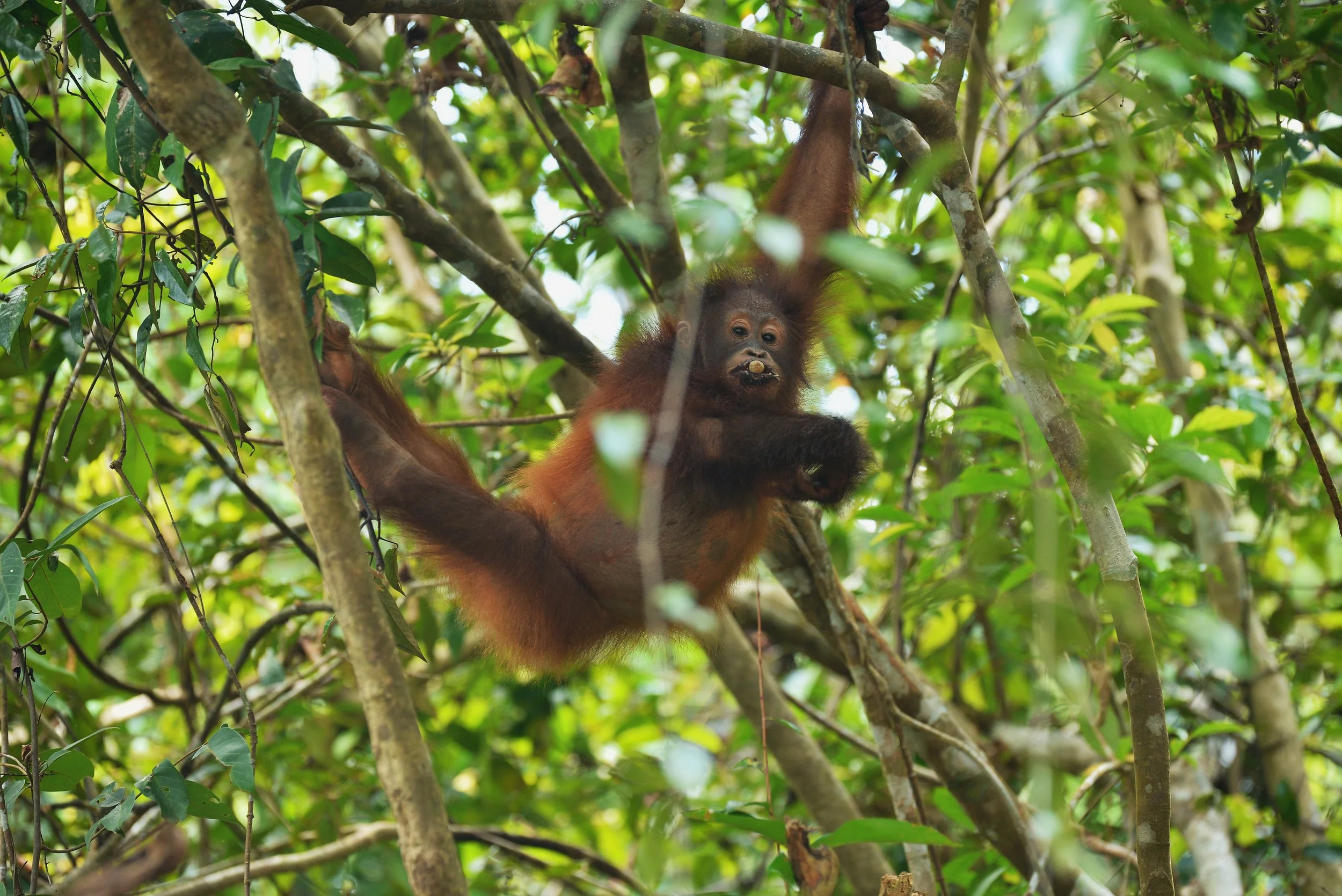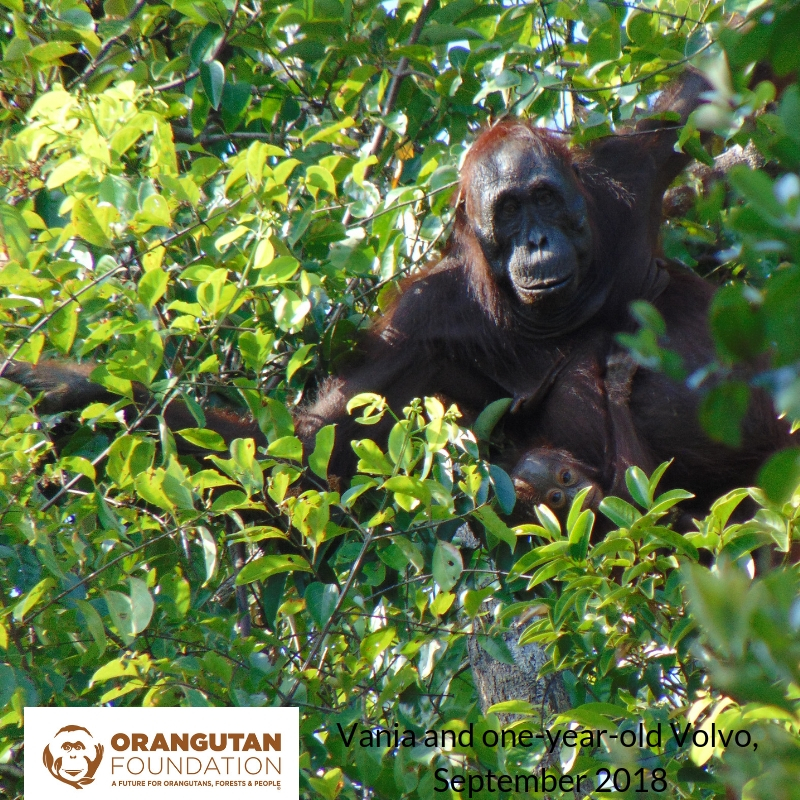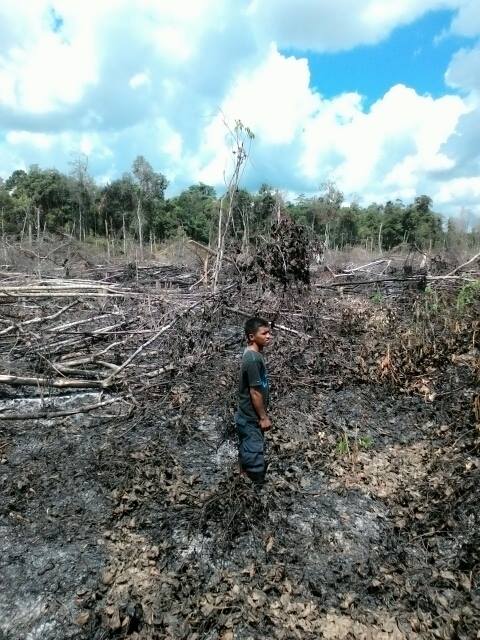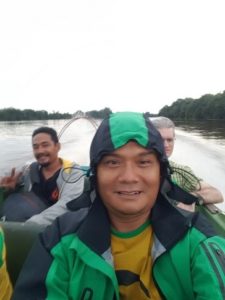Orangutans consume a variety of food from the forest to support their large size. Being arboreal species gives them access to the food they need to sustain their body size.
Hope for orangutans and their forest home
The Indonesian government has announced a presidential instruction, which ordered ministers and regional administrations to ban issuing permits for new plantations for the next three years. We welcome this much needed action. Orangutans can survive, if given a second chance.
Three years ago, in September 2015, we rescued an adult orangutan and her 6-year-old from an oil-palm plantation, which they had entered to escape raging forest fires. Our rescue team managed to capture both orangutans. They named the mother Vania and her offspring Venty. They were released into the protected Lamandau Wildlife Reserve, Central Kalimantan, Indonesian Borneo.
In 2017, Vania was spotted with a newborn, who we named Volvo. Venty, now aged 8-years-old, was still around too.
This month, field staff at Camp Buluh, in the wildlife reserve, saw Venty (image below) by herself in a tree. They then saw Vania with her very healthy looking one-year-old Volvo.
These orangutans live in a protected area, which is guarded and patrolled by Orangutan Foundation. However, 80% of wild orangutans live outside protected areas. This 3-year ban on plantation expansion is the life-line this critically endangered species need.
Please DONATE to support our work.
Thank you.
Wild cats at Pondok Ambung station, Indonesian Borneo
Below are some images taken from camera traps at Pondok Ambung Research Station, Tanjung Puting National Park. In 2017, Orangutan Foundation, awarded three research scholarships to Indonesian students. One of them is Reza Bayu Firmansyah. Reza is conducting research on the density and distribution of wild cat species to complete his Master's Degree at UGM - Gajah Mada University.
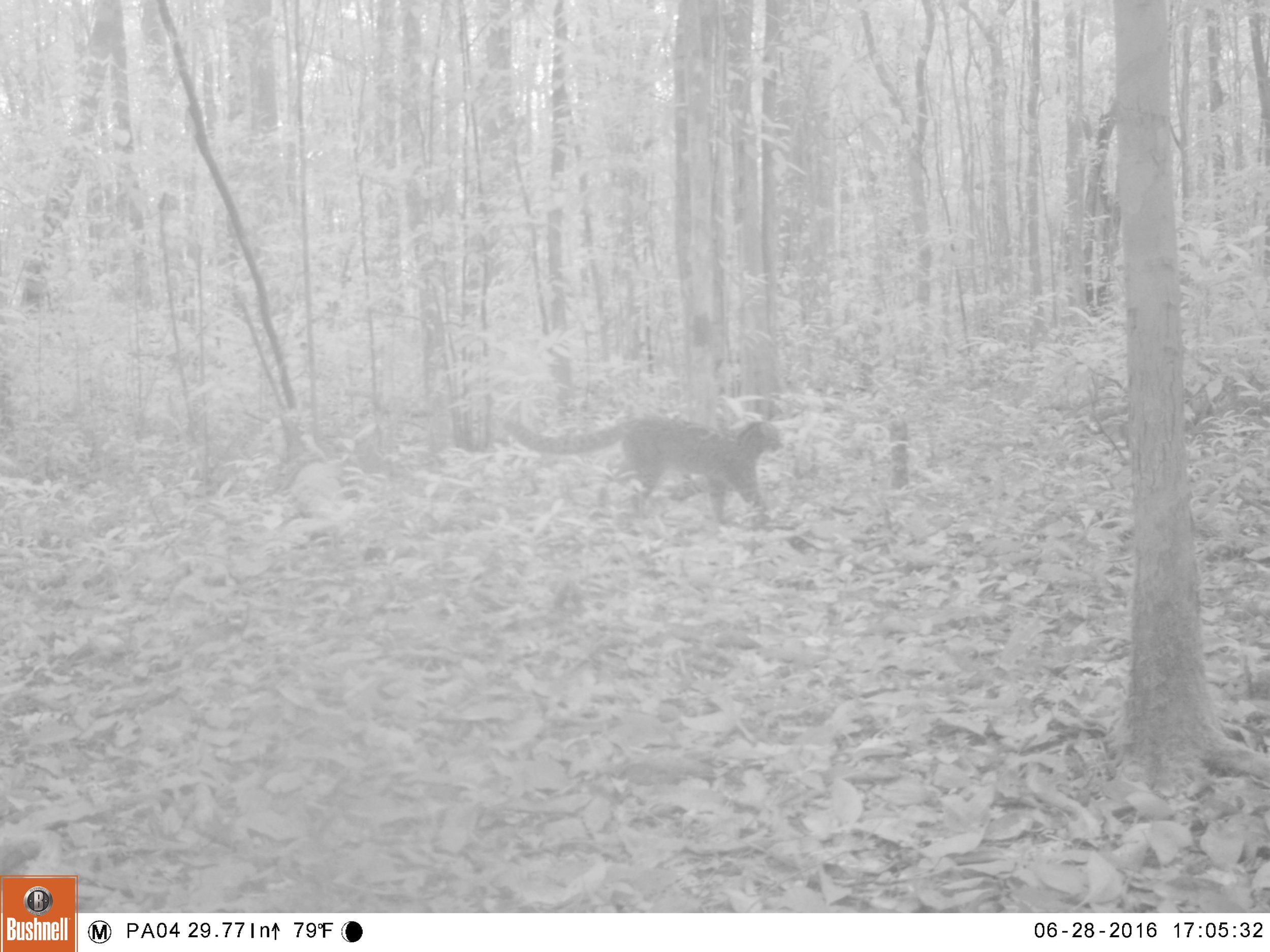
Around the Pondok Ambung Research Station area our staff and Reza think there are 3 individual clouded leopards (Neofelis diardi) all from one family. A male, female and juvenile this based on their size and where they where and when they were photographed.

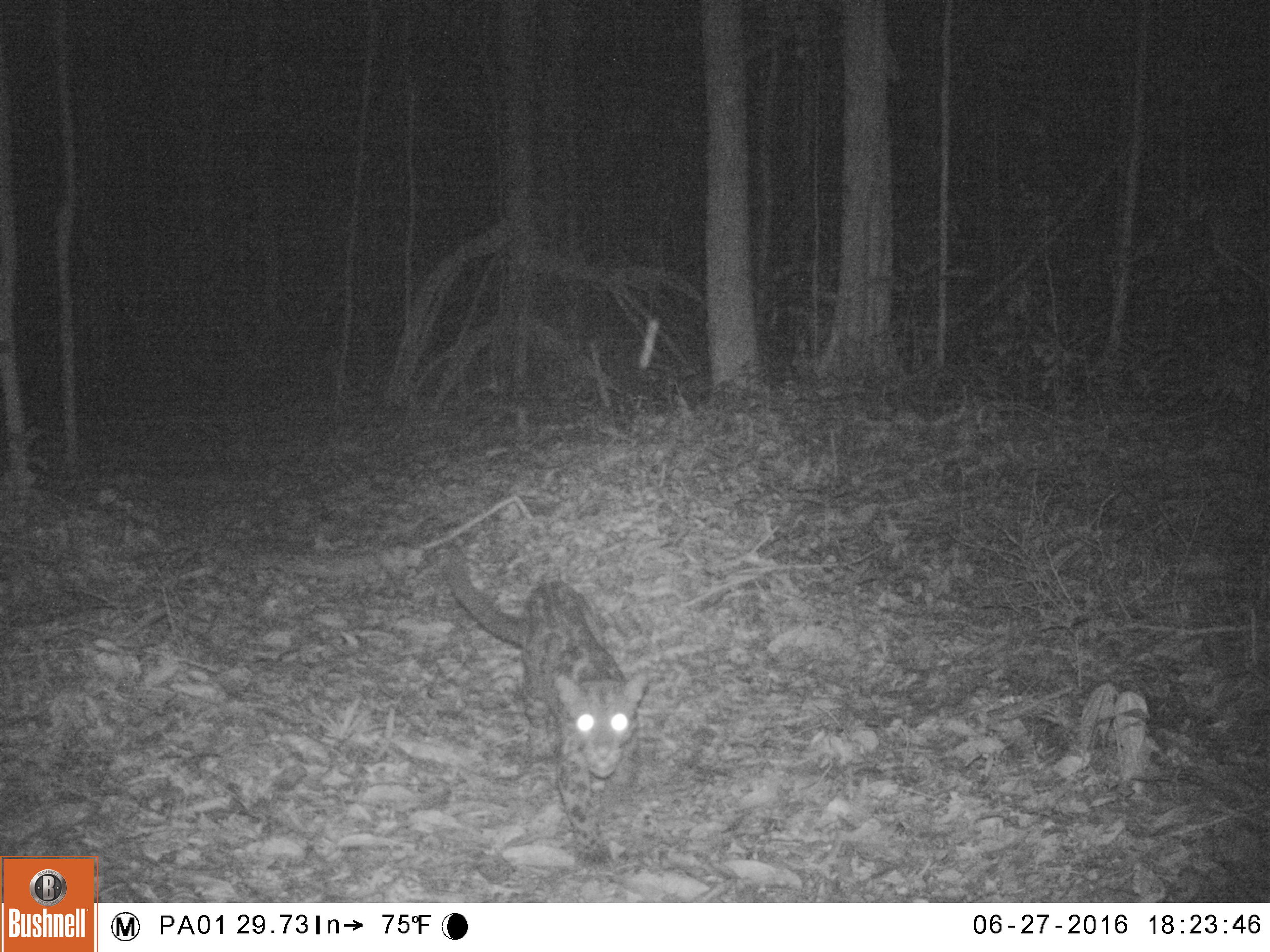
Clouded leopards are a threatened species and it is vital that we learn more about them. Pondok Ambung Tropical Forest Research Station is located in Tanjung Puting National Park, Indonesian Borneo and is run by the Orangutan Foundation in co-operation with Tanjung Puting National Park Authority.
Please donate to support our work.
Thank you.
"All my days in the field are special, but on occasion something really exciting happens - a fight between two male orangutans and we were able to film it." - Ashley Leiman OBE
No sooner had our speedboat arrived at Camp Buluh when the staff came running and excitedly told us to hurry up. I knew before I reached the end of the jetty by the noise of breaking branches that something was going on in the forest ahead.
It didn’t take me long to see one huge male being pursued by another, both cheek padded. The assistants told me that they were Yoko, who was often seen around Camp Buluh, and Darwin, who hadn’t been seen for a number of years.
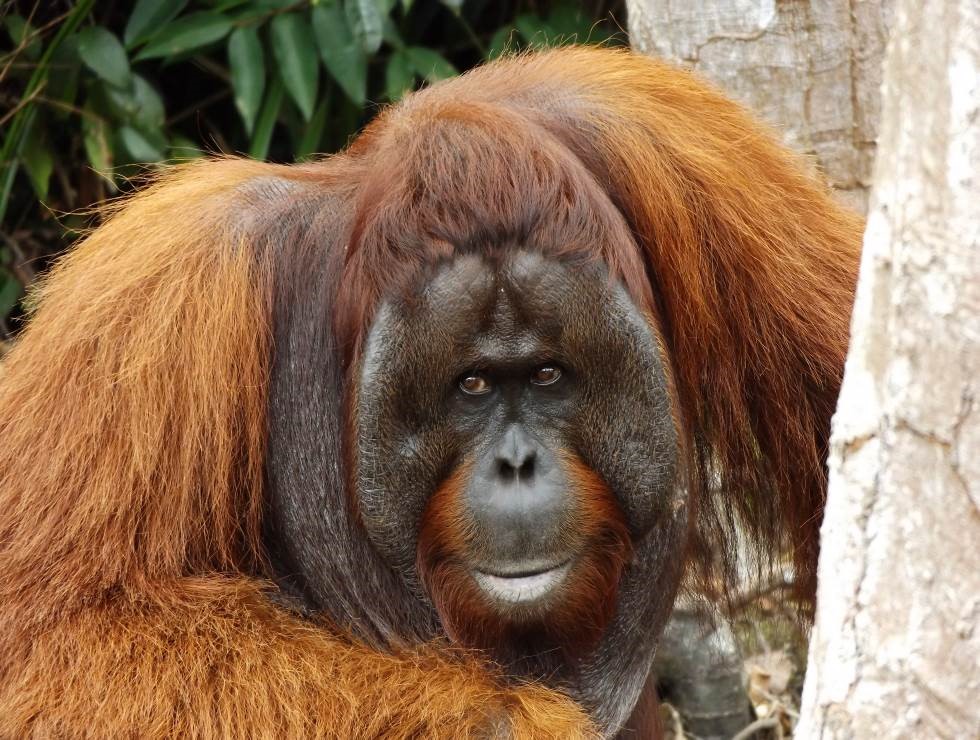
The orangutans were face-to-face in open combat. They would grapple one another, no doubt inflicting some injuries. This would last for a number of minutes until one would go further into the forest and there would be a lull in the confrontation.
There were times when both came down to the ground, one aggressively pursuing the other, before going back up into the trees. What was interesting was that during the conflict they would occasionally stop to rest, so obviously this activity takes a lot of energy.
Long calls and branch cracking perforated the performance. This encounter went on for over two hours before Darwin, realising Yoko had the upper hand, made his way further into the forest and was not followed. That’s what I love being in the field, it’s never boring, it’s not every day one sees such excitement.
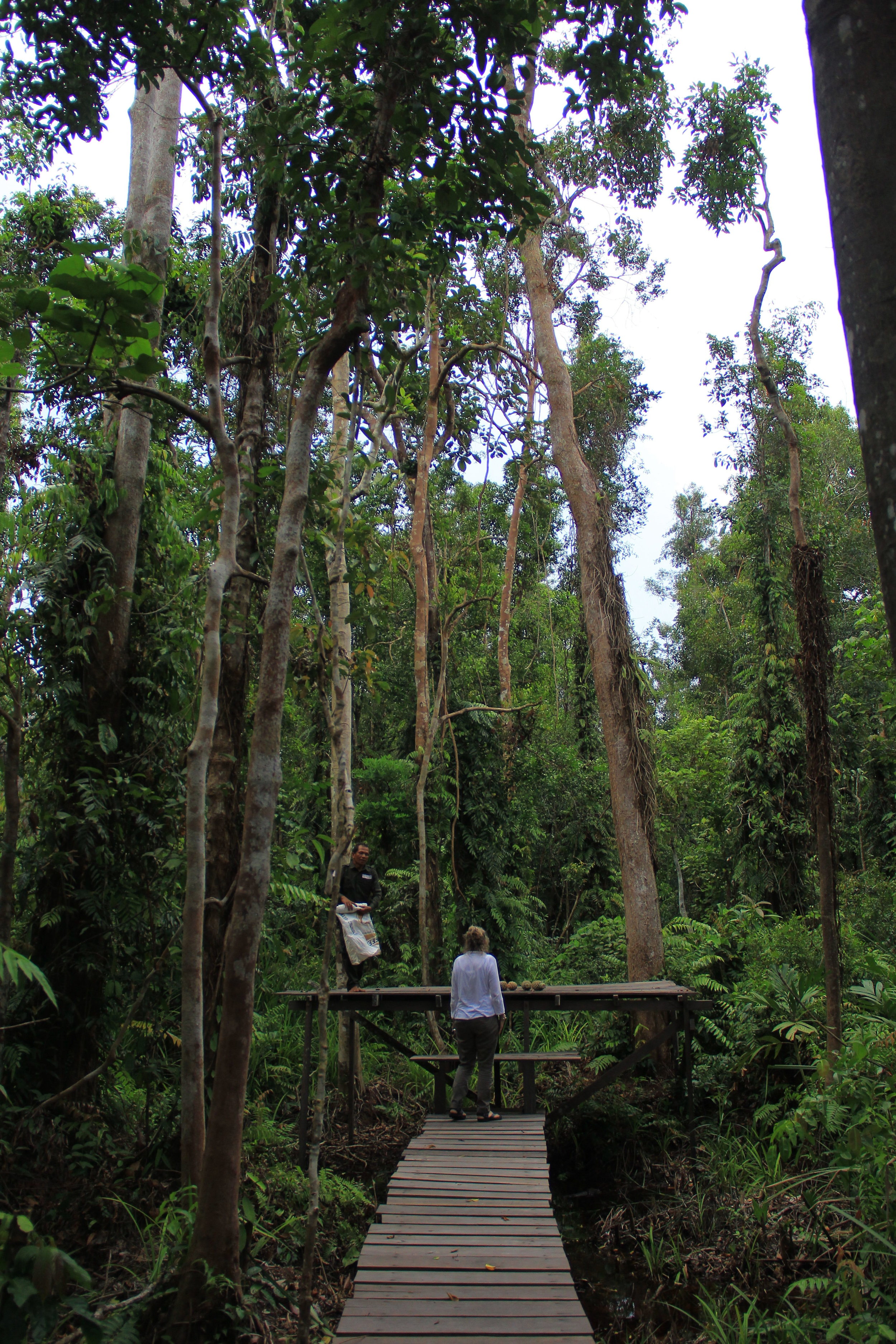

Become a Guardian of Lamandau today and help us protect the home of Yoko, Darwin and over 500 other critically endangered orangutans. Click here to find out more.
Thank you.
Ashley Leiman OBE, Director
Have your donation doubled for free and support Borneo's wildlife conservationists
From 28th November until 5th December you can DOUBLE your donation through the Big Give Christmas Challenge, at no extra cost to yourself. Click here to donate and double your impact to support our work. This year our we are raising funds to inspire Borneo’s future conservationists. In this clip Arie, Research Manager of Pondok Ambung, our tropical forest research station in Tanjung Puting National Park, explains why it is important.
We use camera traps to monitor the wildlife in the forests surrounding Pondok Ambung. Watch this short clip to see some of the species we’ve managed to capture on film!
To protect Indonesia’s biodiversity, future conservationists need to be encouraged and supported.
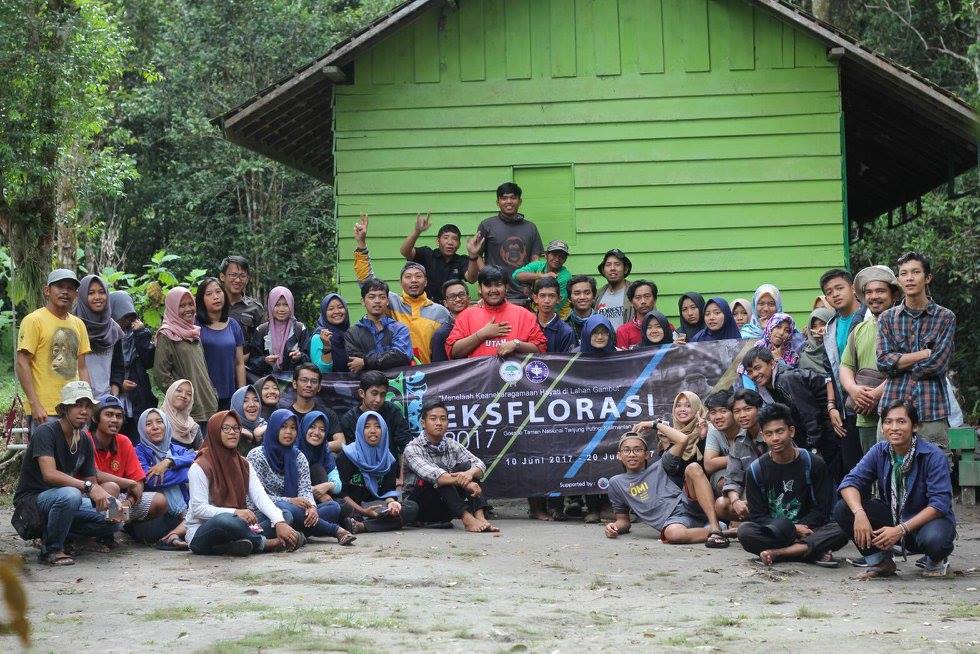
Our research station is a base from where Indonesian students and international scientists can conduct research. Take a virtual tour below:
Please help us to ensure a future for orangutans, forests and people.
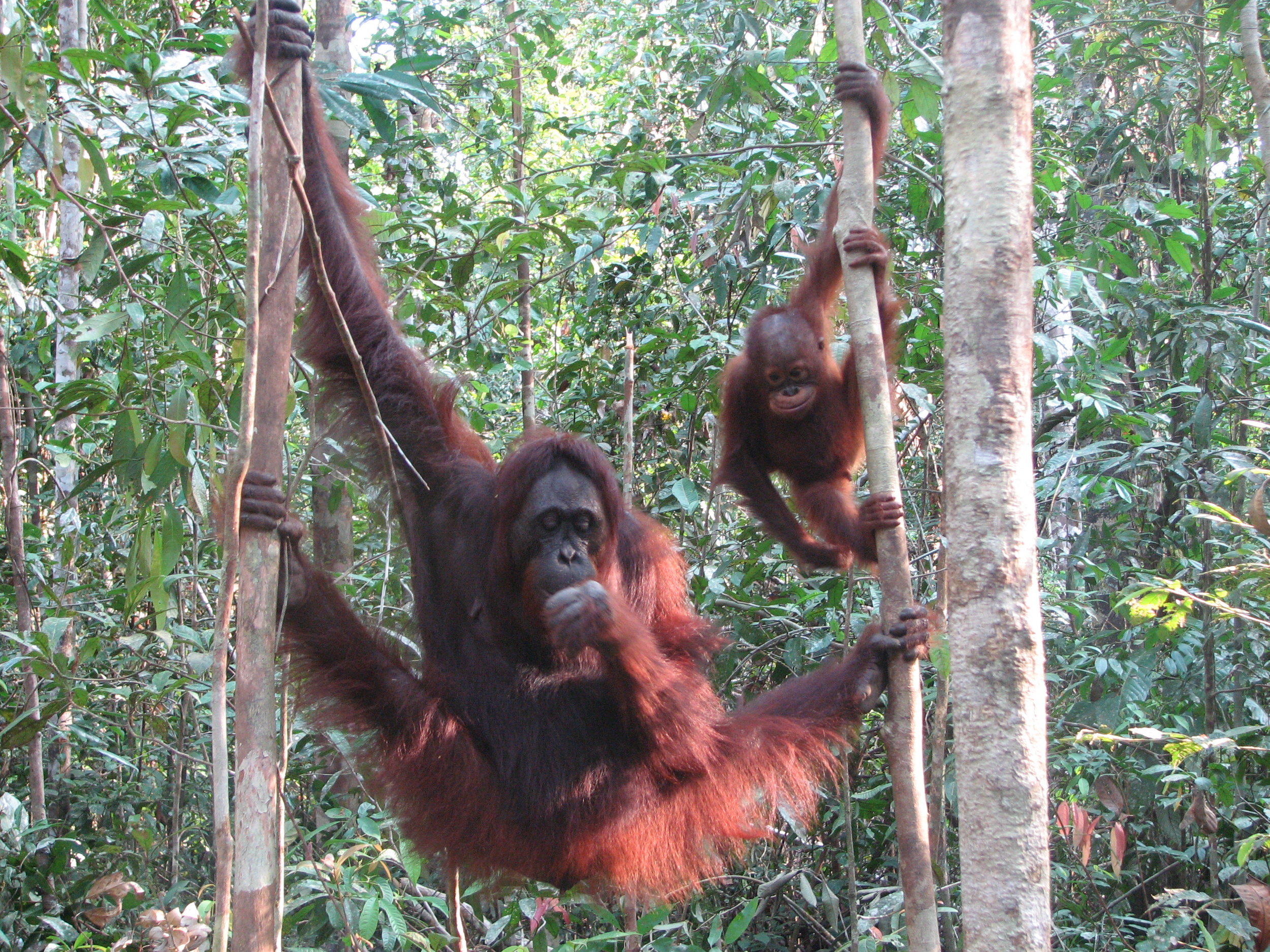
Thank you for your support. Click here to DOUBLE YOUR DONATION through the BIG GIVE.
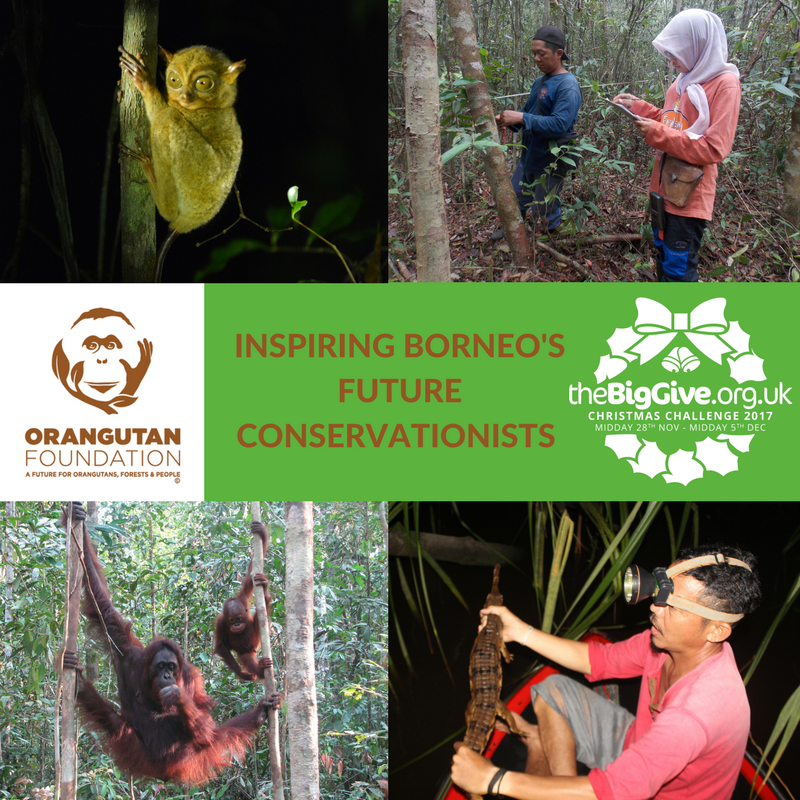
Meet Aan the orangutan
To celebrate Orangutan Awareness Week, we are telling the stories of some of the orangutans who have been given a second chance thanks to your support for our work, but unfortunately, not all have a second chance in the wild. Aan
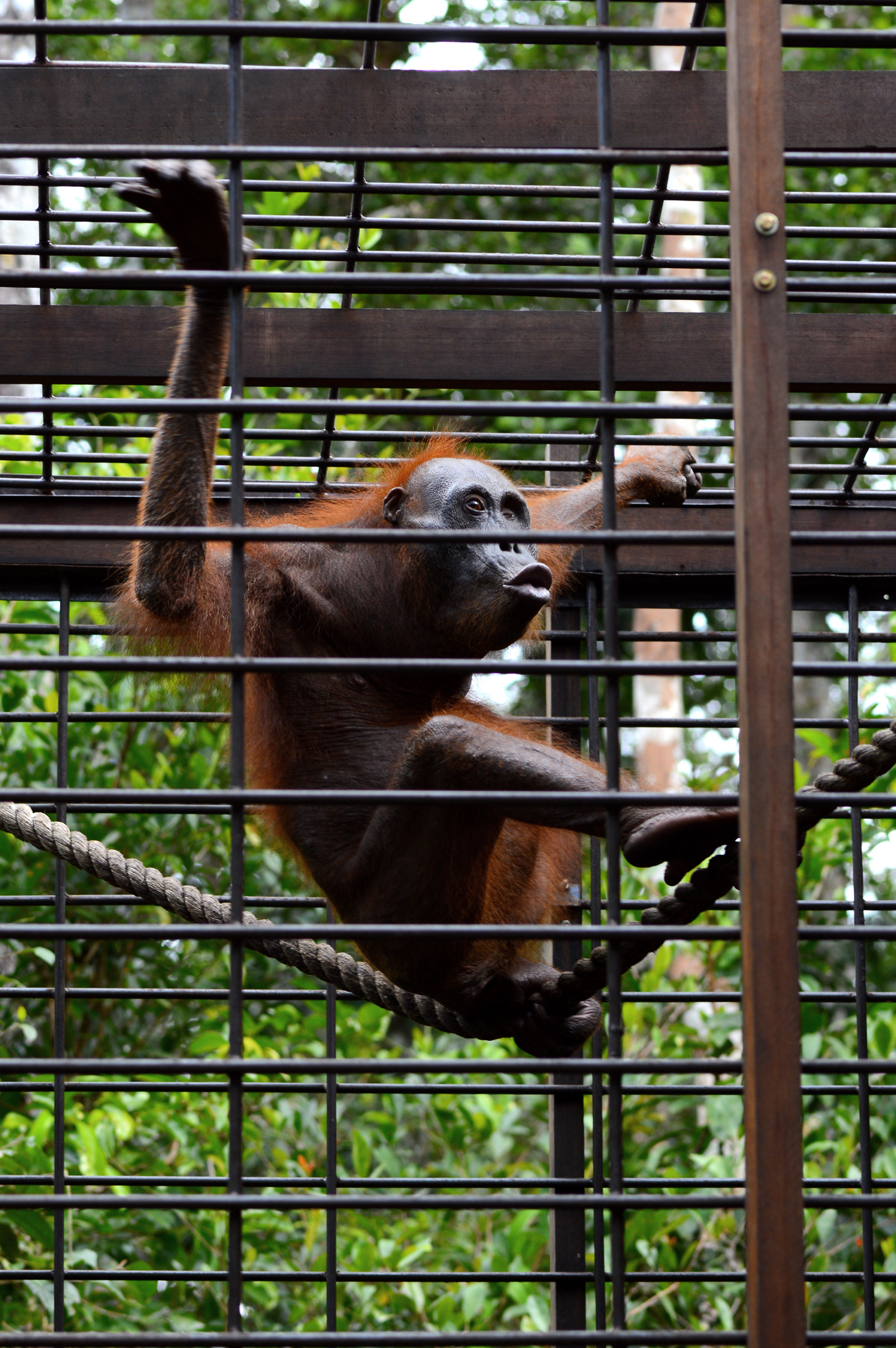
Aan is a blind orangutan. She first came to us in 2012, having been found stranded on an oil-palm plantation, after being shot over 100 times with an air gun. The injuries sustained left Aan blind. You can read more about her rescue here.
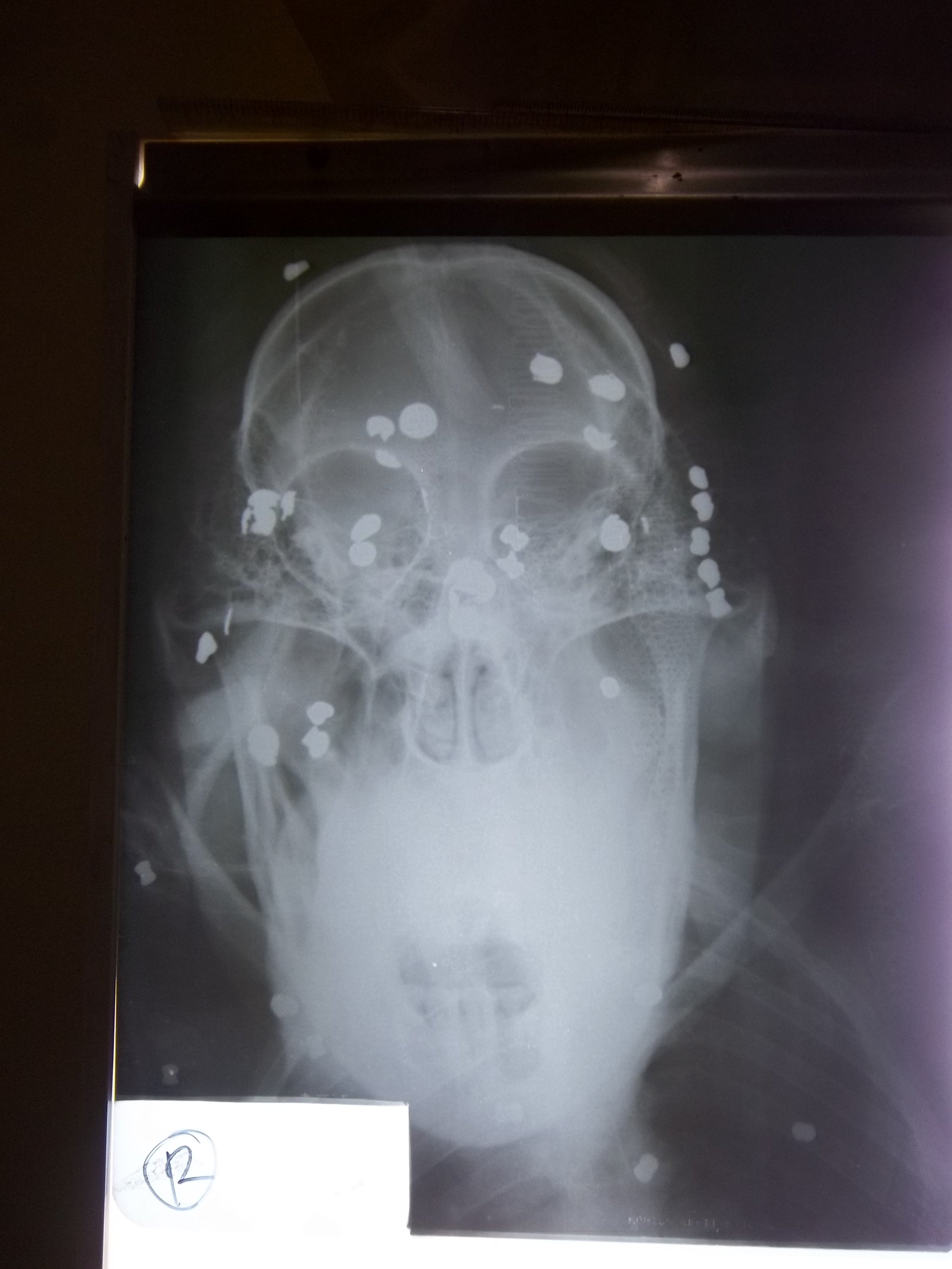
In 2016, we arranged for an ophthalmic surgeon to visit Aan to see if there was any chance of restoring her sight, with the hope that one day she could return to the wild. Aan underwent surgery but it soon became clear that the damage sustained was too severe and Aan would be permanantly blind.
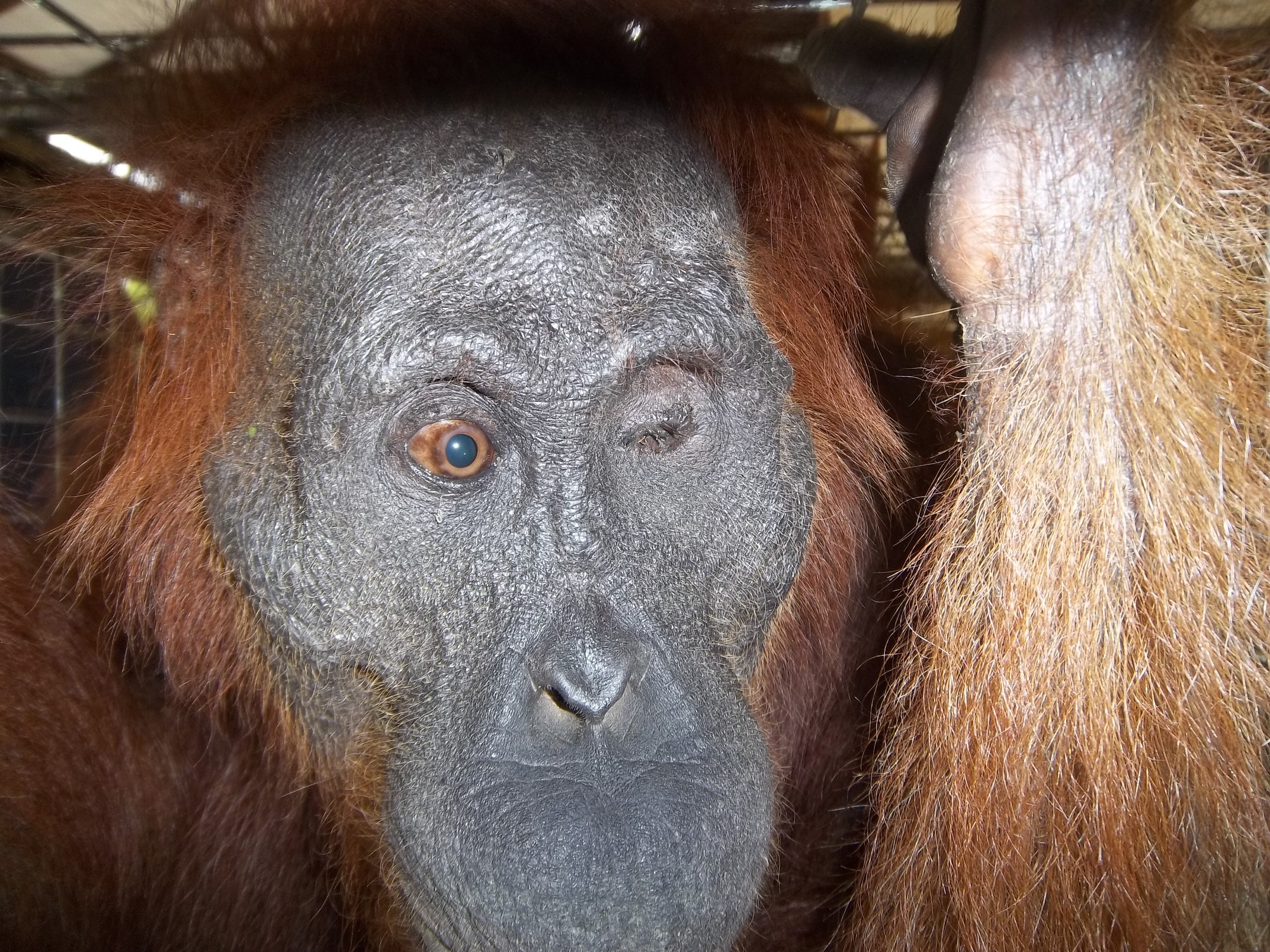
Aan lives in a purpose-built enclosure at Camp Gemini, where our vet clinic is located, in the Lamandau Wildlife Reserve. Our staff give her the best quality of life that is possible, but sadly Aan can never return to the forest, where she belongs.
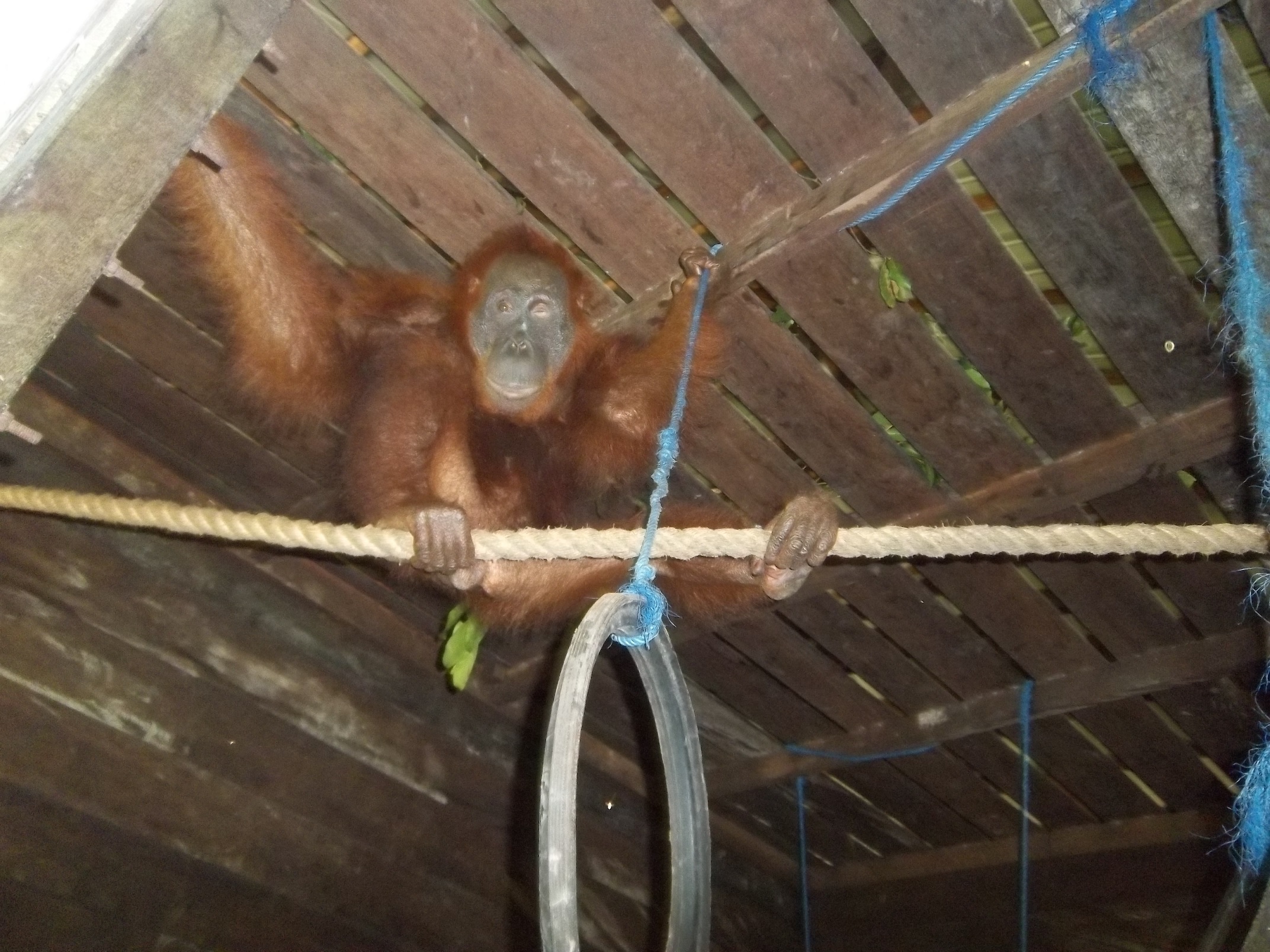
Aan’s story serves as a heartbreaking reminder that the threat to orangutans caused by habitat loss is a very real one. Please support our care of Aan during Orangutan Awareness Week by donating here.
Meet Kotim the orangutan
It is Orangutan Awareness Week and each day we will bring you a story about the orangutans in the Lamandau Wildlife Reserve. Thanks to your support we are protecting their forest home the Lamandau Wildlife Reserve and keeping them wild and free. Kotim
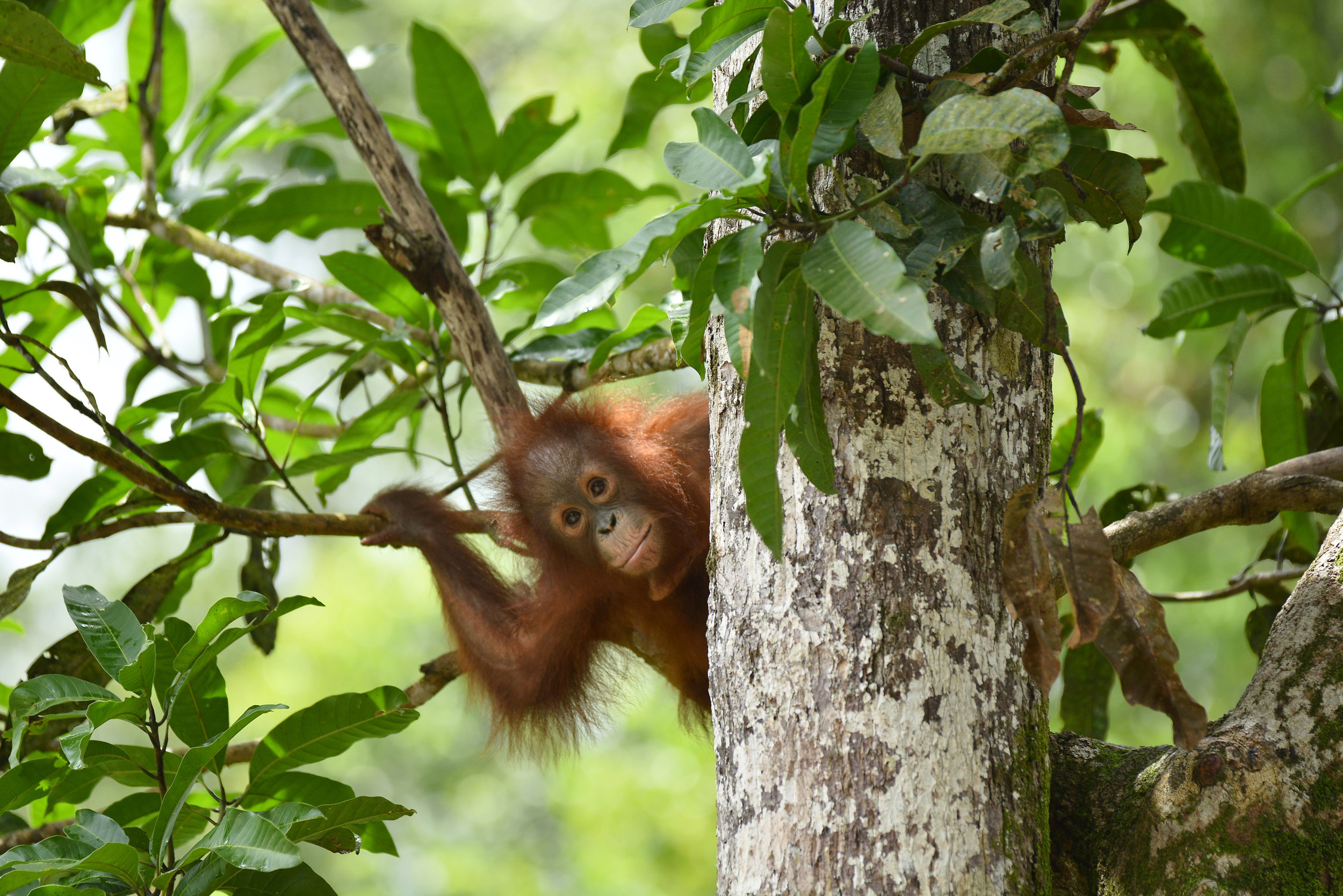
Kotim was rescued in 2014. She was handed over to Orangutan Foundation after being illegally kept as pet. Sadly, we can only assume that her mother was killed.
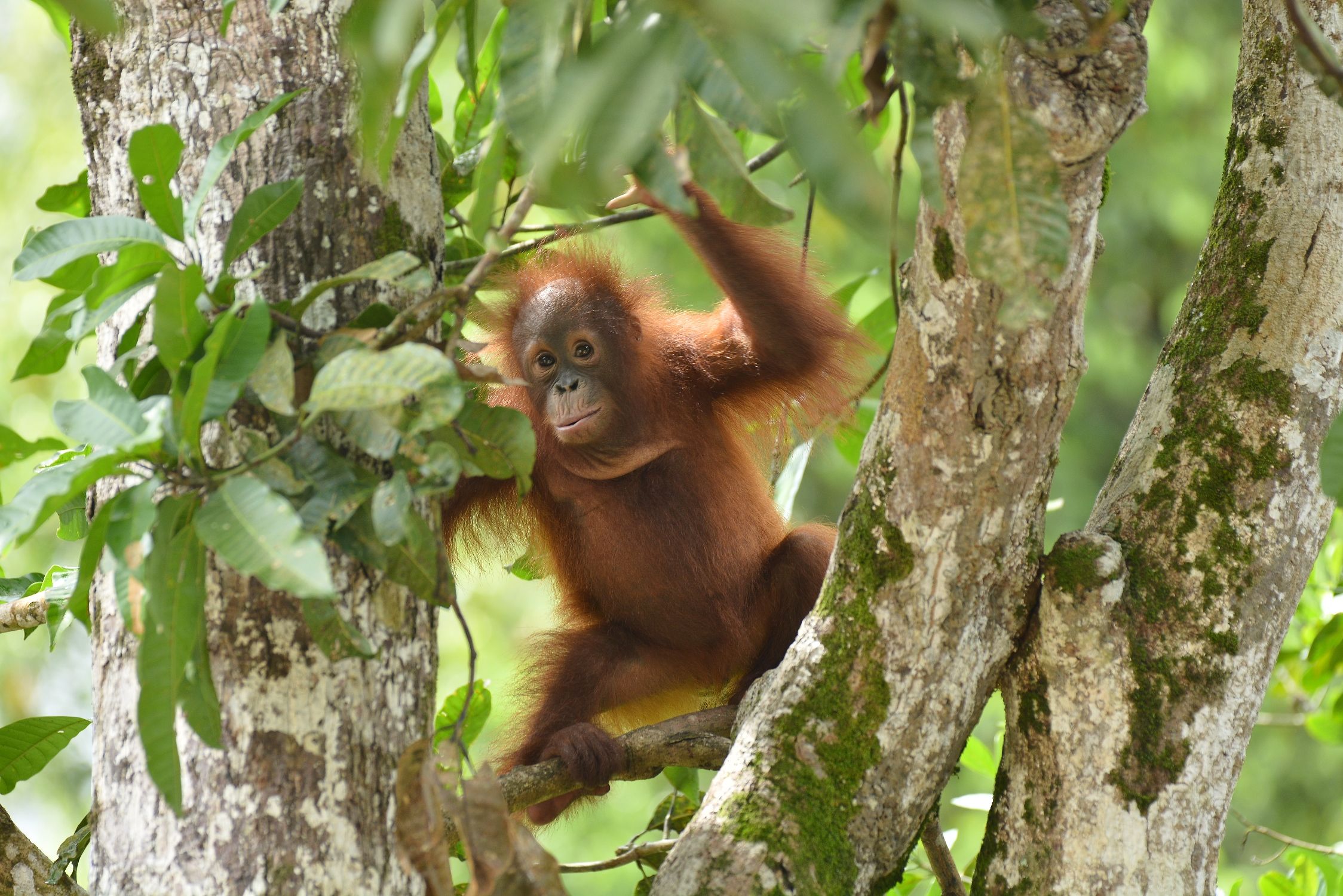
At three-years-old Kotim was too young to be released back into the wild and so entered into the care of our Soft-Release Programme, at Camp Rasak in the Lamandau Wildlife Reserve, Indonesian Borneo. Kotim joined another infant orphan, Torup. They became playmates and together practised their nest-building and climbing skills.
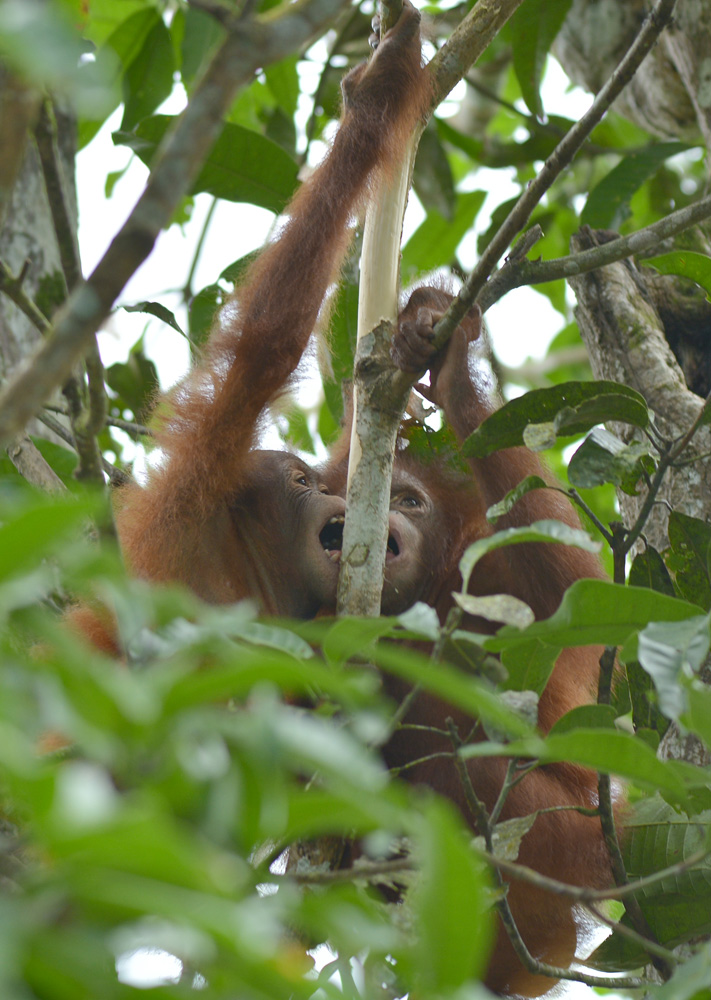
By April 2016, Kotim was deemed to have all the skills needed to survive in the forest and was successfully released. She is still occasionally seen by Orangutan Foundation staff. In December 2016, Kotim was seen with adult female orangutan Acuy and her infant, Ariel.
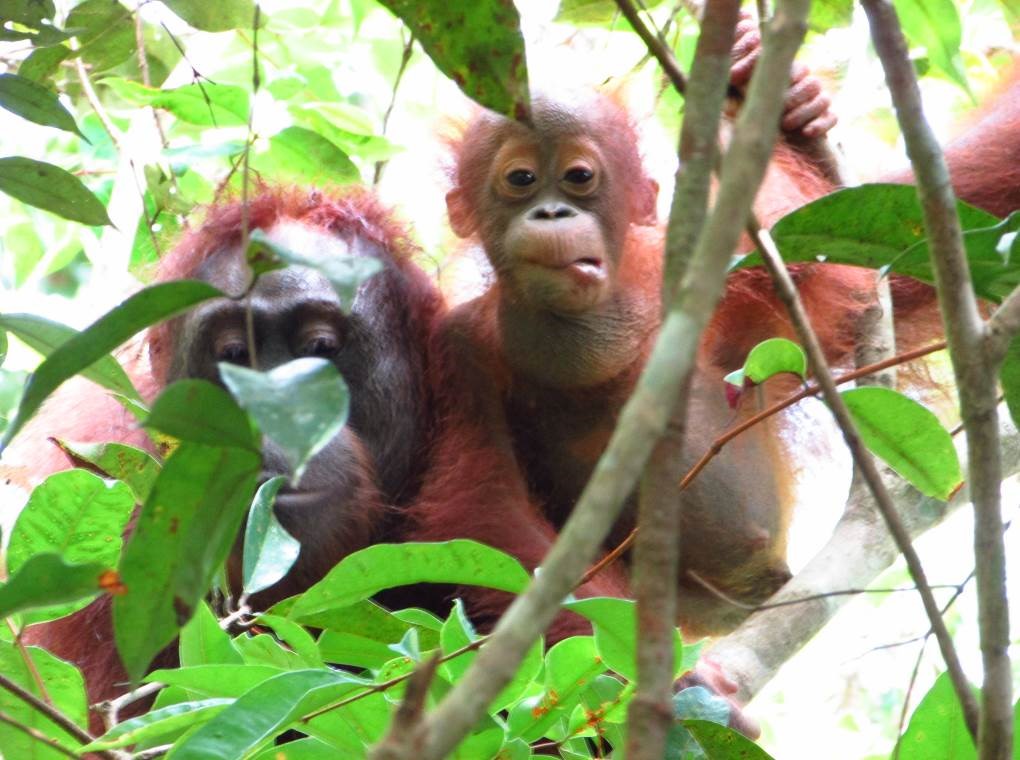
Support Kotim during Orangutan Awareness Week. Please donate to help us protect her tropical forest home. Keep forests standing and orangutans in the wild.
Please donate here.
Here's a video of Kotim whilst under our care in our Soft-Release Programme:
Meet Bangkal the orangutan
To celebrate Orangutan Awareness Week, we are telling the stories of some of the orangutans who have been given a second chance thanks to your support for our work. Bangkal
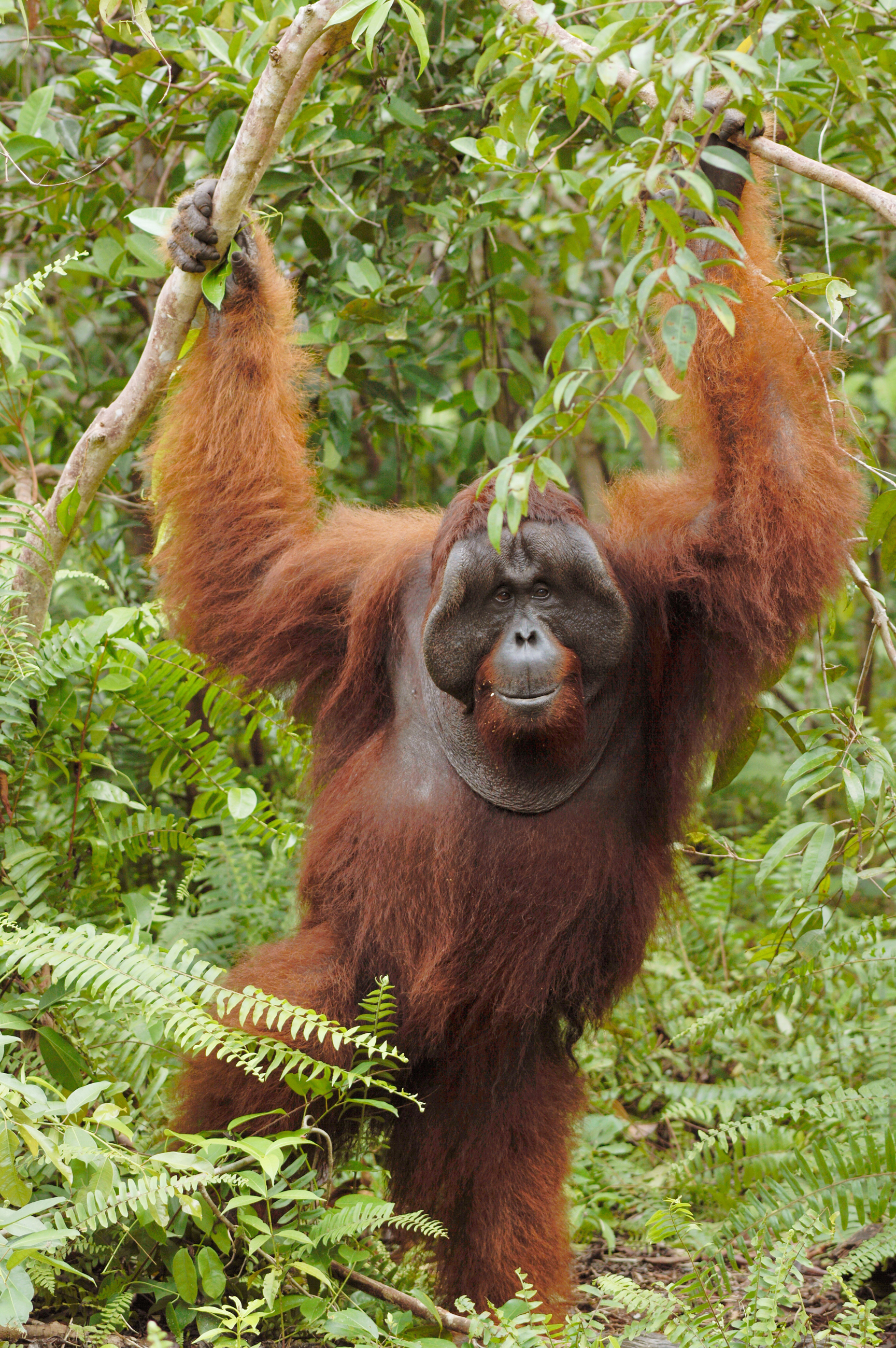
In the late 1980’s Bangkal was an orphaned infant, being kept as a pet. He was rescued, rehabilitated over many years, and then released into Tanjung Puting National Park, Central Kalimantan Indonesian Borneo.
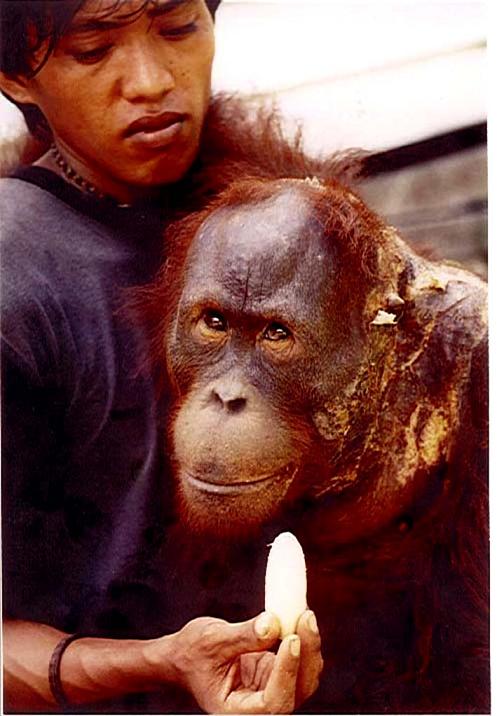
In 2000, when illegal logging was rife in Indonesia’s National Parks, Bangkal became the victim of a horrifying incident. Illegal loggers threw hot oil over him resulting in a burn down his face and neck.
During his recovery, Bangkal protected himself from annoying insects, by using a blanket to cover his injured face. Once recovered, Bangkal was released again but this time into the Lamandau Wildlife Reserve.
Now aged around 28 years-old, cheek-padded Bangkal is magnificent. He is the dominant male around Camp Gemini and is thought to have fathered many offspring.
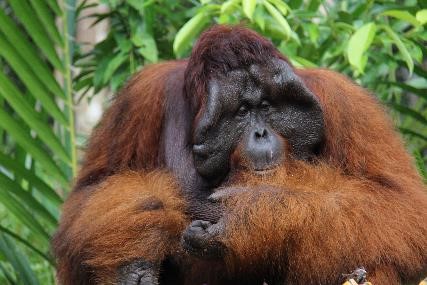
Support Bangkal during Orangutan Awareness Week! Please donate here to help us protect Bangkal in his forest home.
Meet Holahonolulu the orangutan
To celebrate Orangutan Awareness Week, we are telling the stories of some of the orangutans who have been given a second chance thanks to your support for our work. Holahonolulu
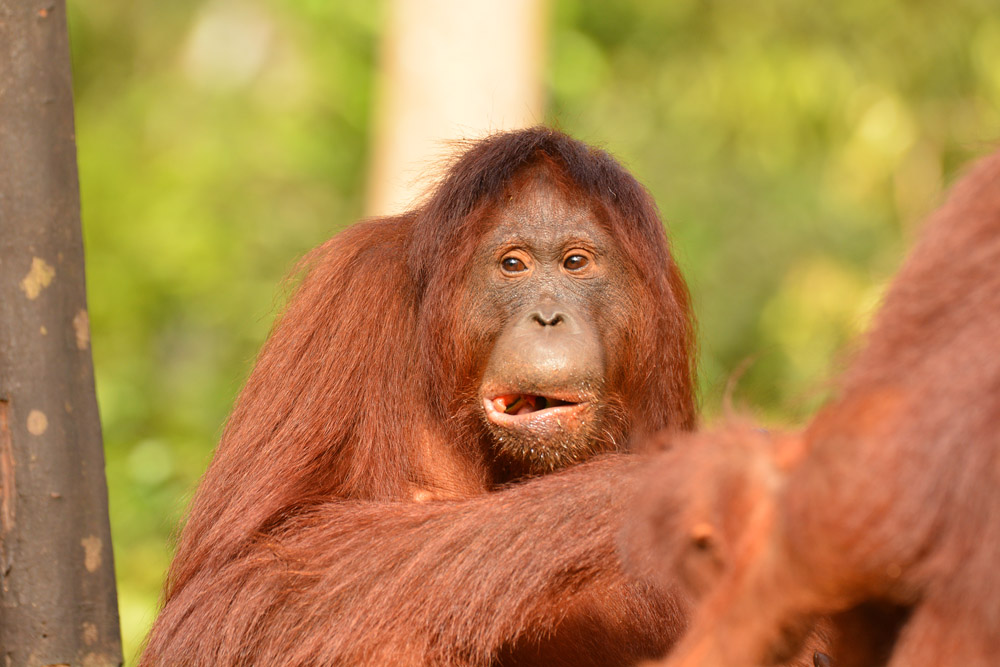
Holahonolulu is a wild born adult female orangutan. Her mother, Huber, was released into the Lamandau Wildlife Reserve in around 2000 and Holahonolulu was born in 2004. Huber unfortunately passed away in 2012.
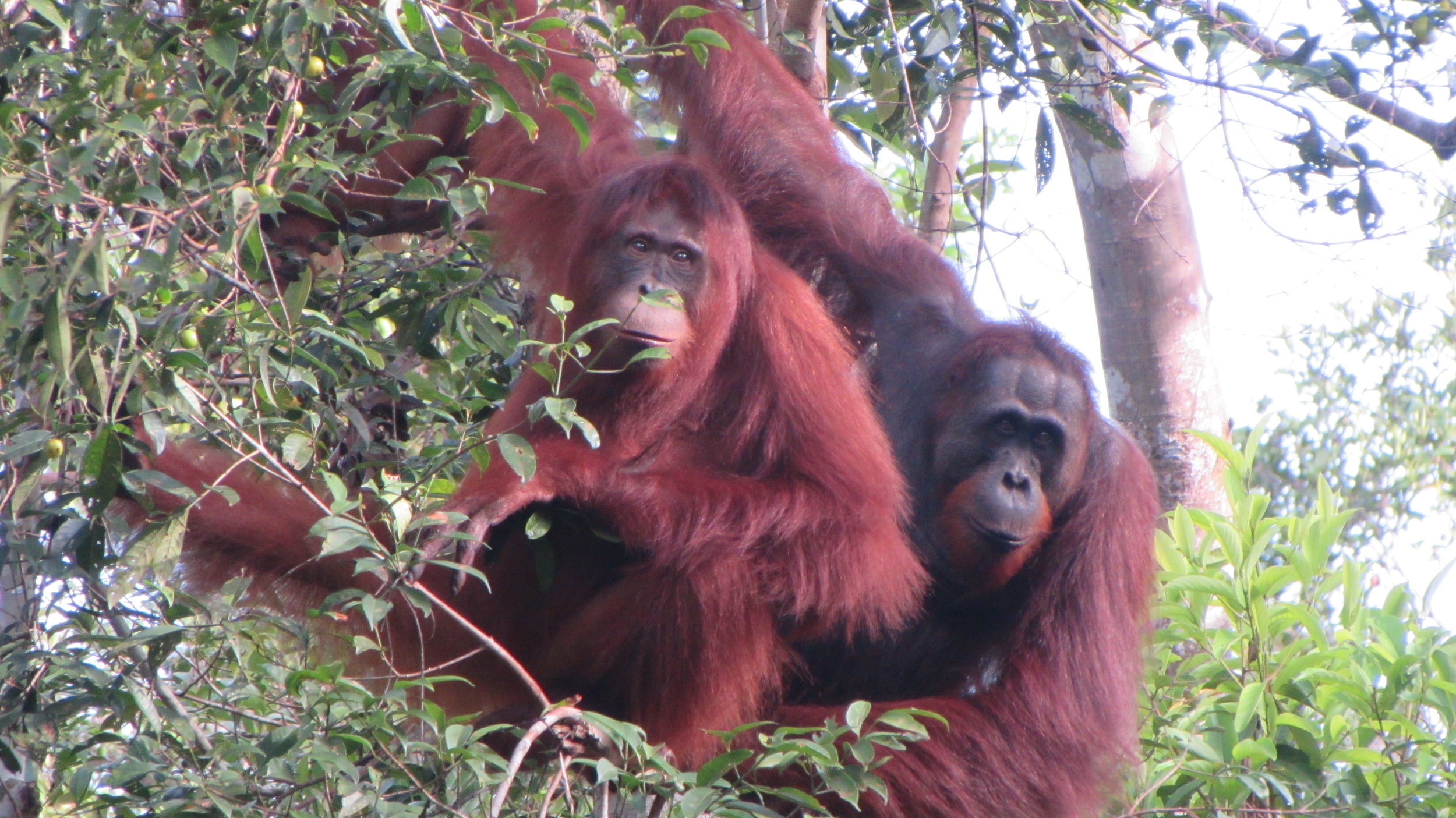
Holahonolulu is often seen by Orangutan Foundation staff at the feeding station, close to Camp Gemini. She been observed with Bangkal, a dominant male, mating on several occasions. Orangutans have a gestation period of about 9 months, it is slightly shorter than humans. Watch this space for the announcement of a new arrival in a few months’ time!
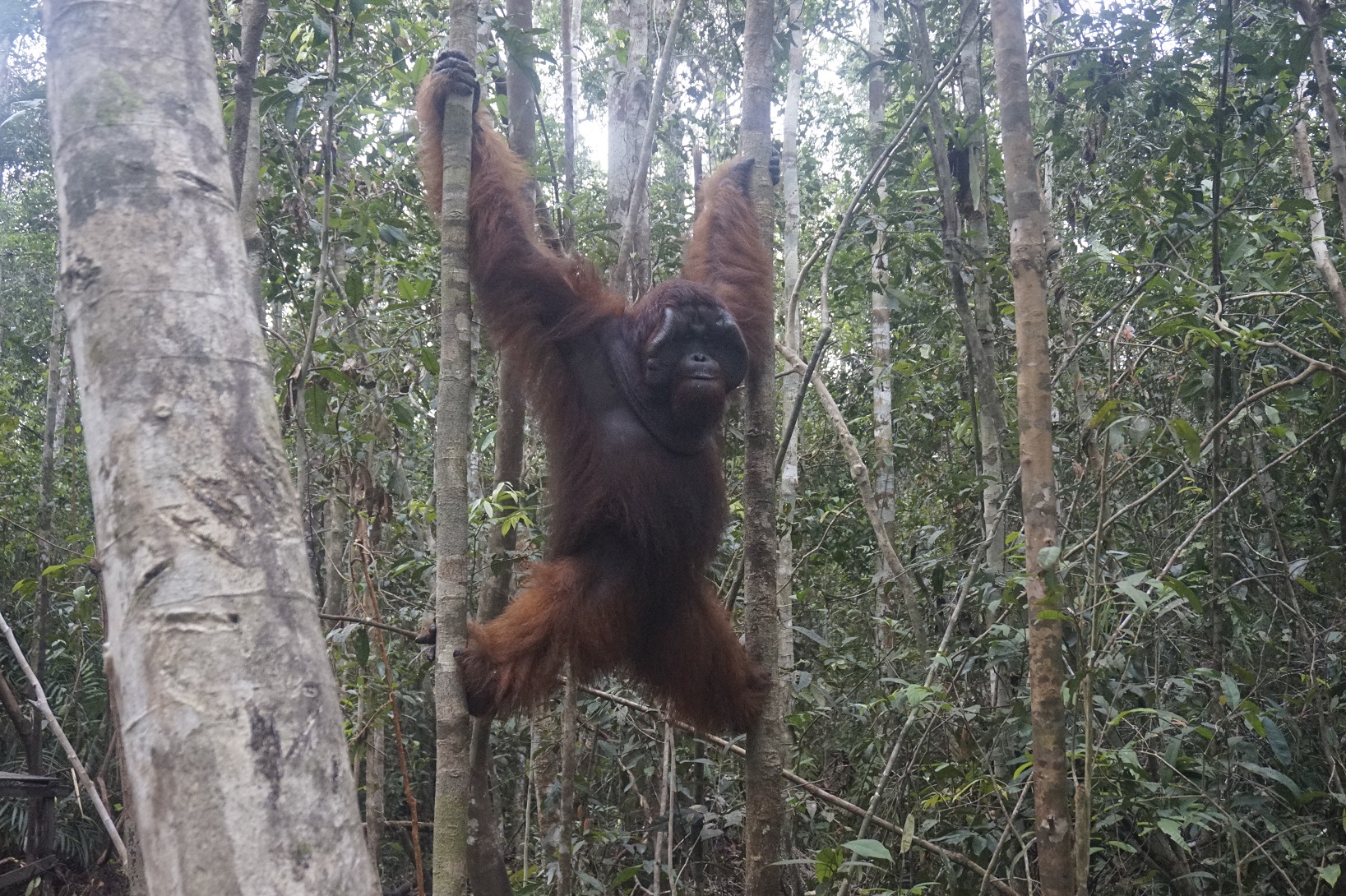
We are delighted when released orangutans go on to produce future generations. The orangutans of Lamandau Wildlife Reserve are now a healthy, viable and growing population.
Support Holahonolulu during Orangutan Awareness Week here! Please donate to help us protect her tropical forest home.
Freedom in the wild
If you want something done, ask a busy person. This expression is especially true for Orangutan Foundation Director, Ashley Leiman OBE, who has just returned from a field visit to our programmes in Central Kalimantan, Indonesian Borneo. One of the highlights was a tree planting ceremony to celebrate the planting out of over 22,000 seedlings in degraded forest habitat in the Lamandau Wildlife Reserve. The most memorable day though involved the return to the wild of seven different species. Captured from the wild and kept as pets, these animals had been confiscated by the Wildlife Department of Central Kalimantan (BKSDA Kalteng). The day was also a chance for Ashley to meet Bapak Adib Gunawan, the new Head of Wildlife for Central Kalimantan, who was overseeing the releases.
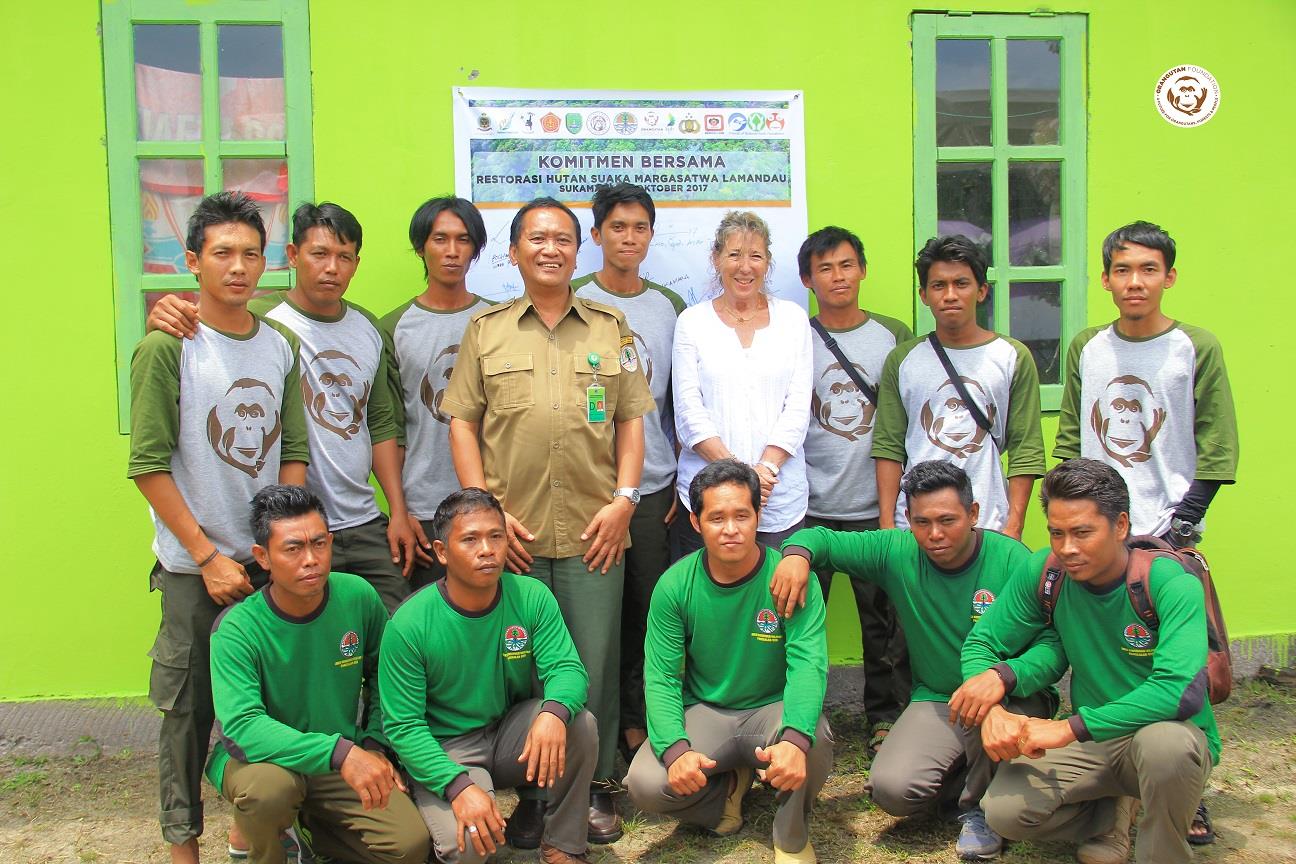
The animals due for release included two changeable hawk eagles, a hornbill, a pangolin, a slow loris, two reticulated pythons, a sun bear and a young orangutan.
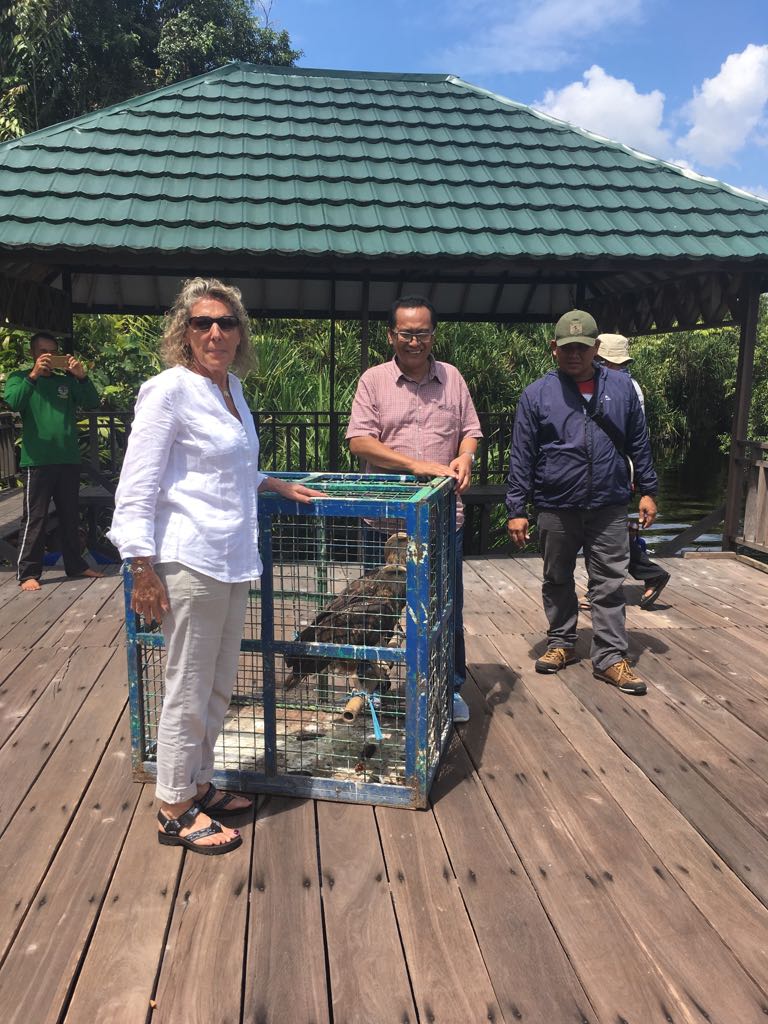
The orangutan, a handsome young male of around one-and-a-half years old, had been kept as a pet in a nearby town. He was named Adib, after the new Head of Wildlife, and has joined our Soft-Release Programme at Camp JL, in the Lamandau Wildlife Reserve, where he’ll learn the skills to survive in the forests.
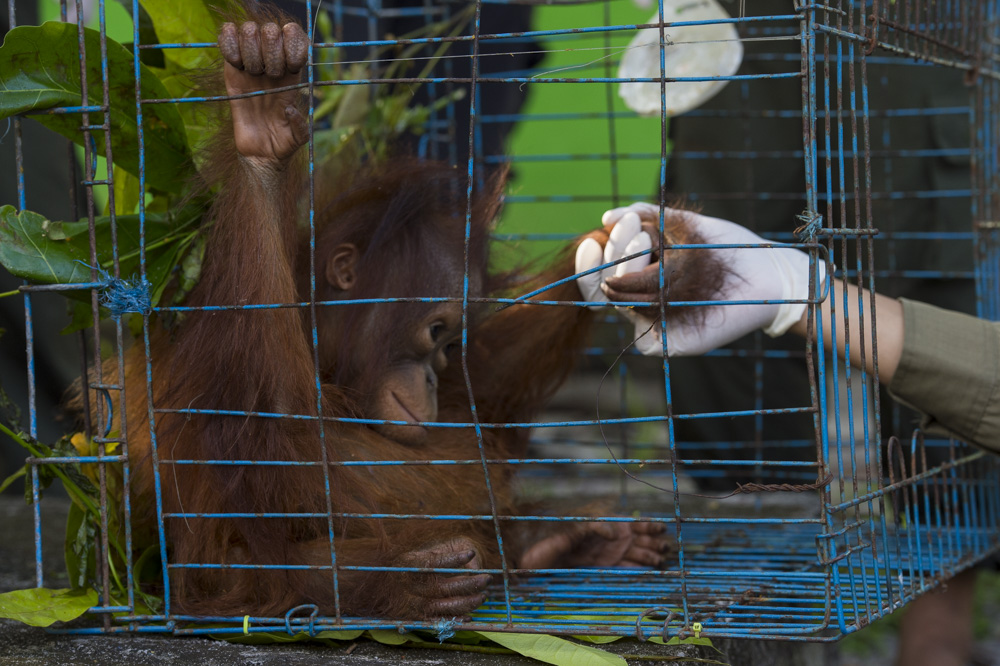
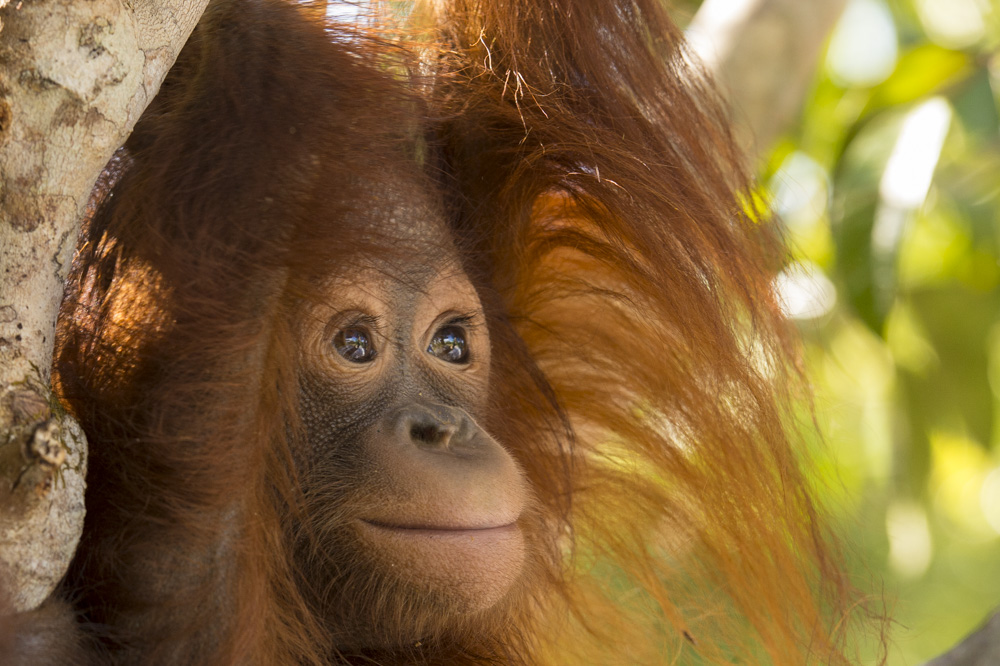
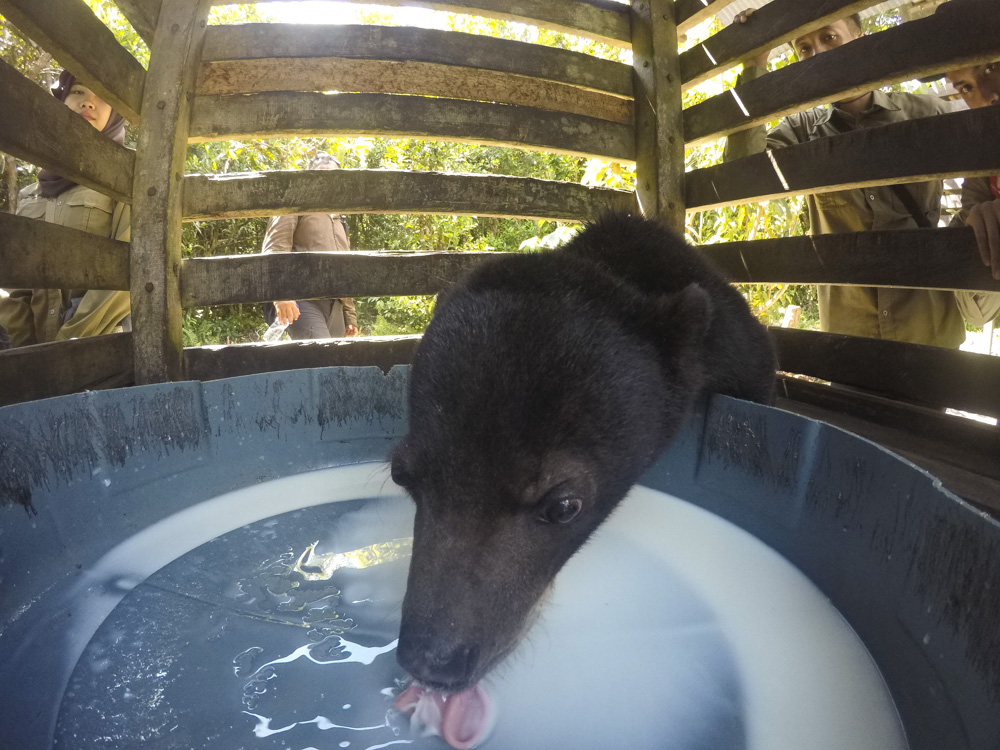
A playful sun bear, named Paddington (also a pet), was taken to Camp Siswoyo, where Orangutan Foundation staff will care for him until he is old enough to live independently. The slow loris, being a nocturnal primate, was released after nightfall.
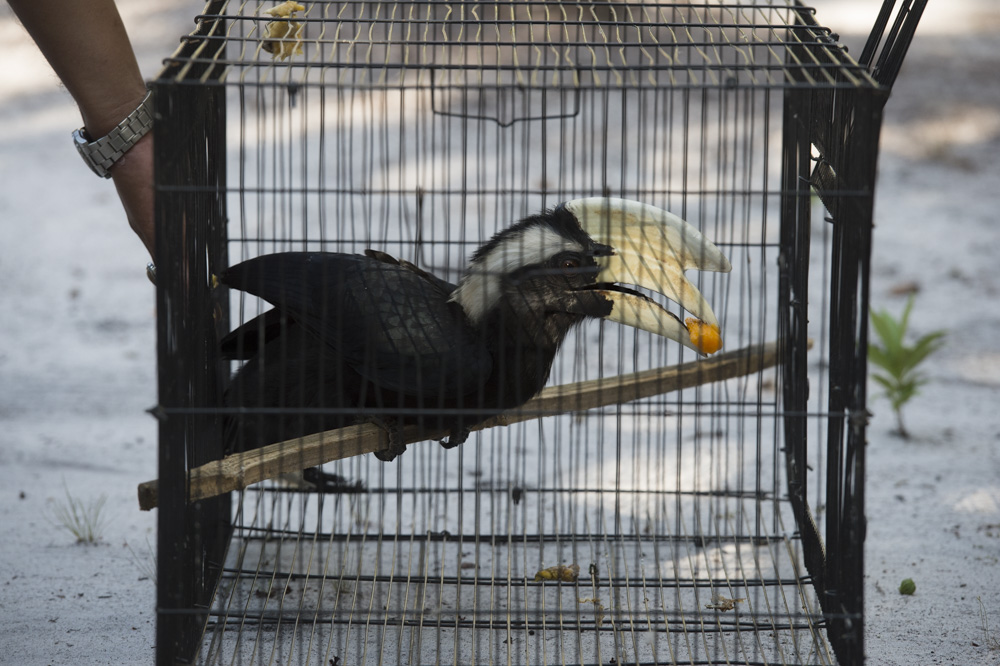
The changeable hawk eagles and hornbill were released from a guard post in the reserve, and Ashley opened the slide door to the crate of the pythons.
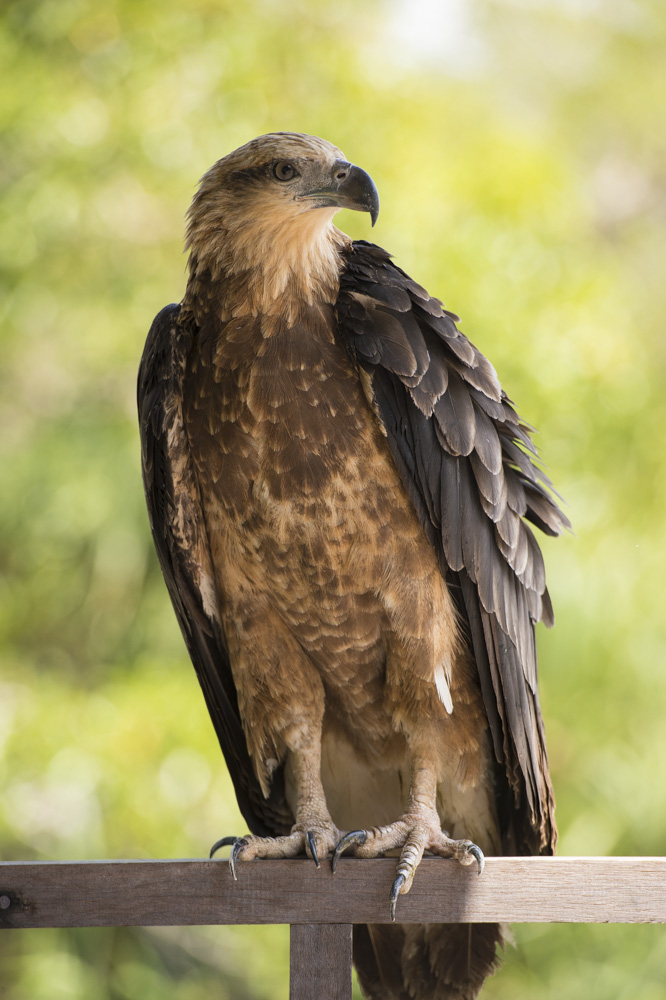

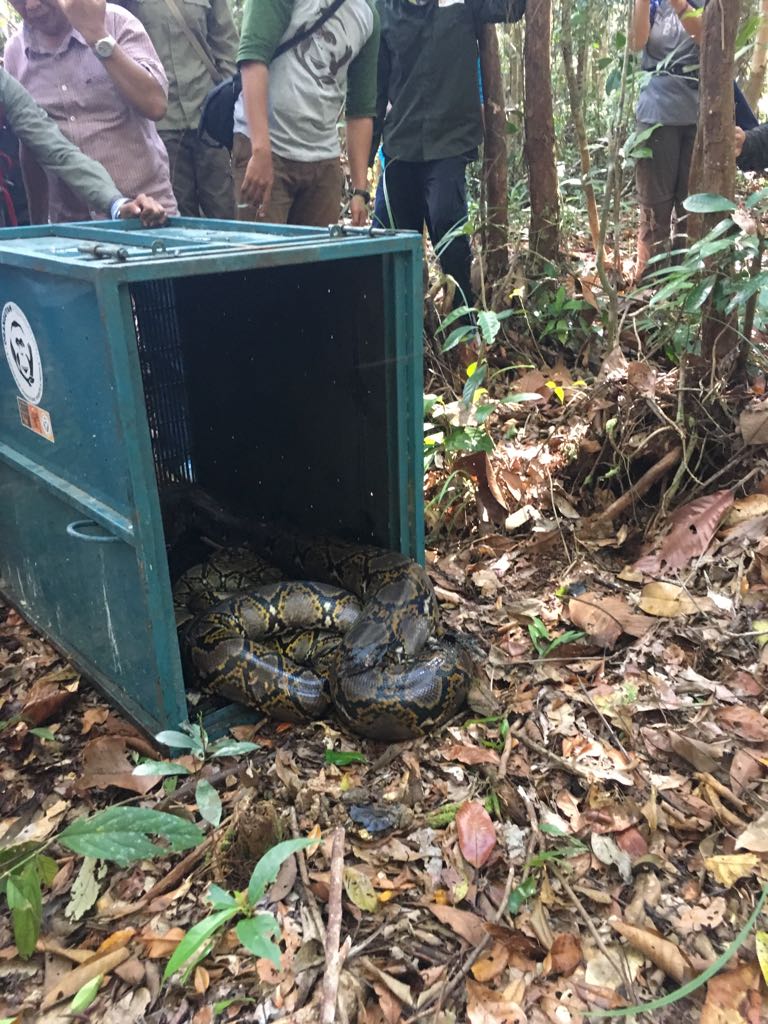
Over 3 meters in length, Ashley questioned why anyone would want to keep the snakes as a pet! We’ll post a separate blog on the pangolin, so watch this space.
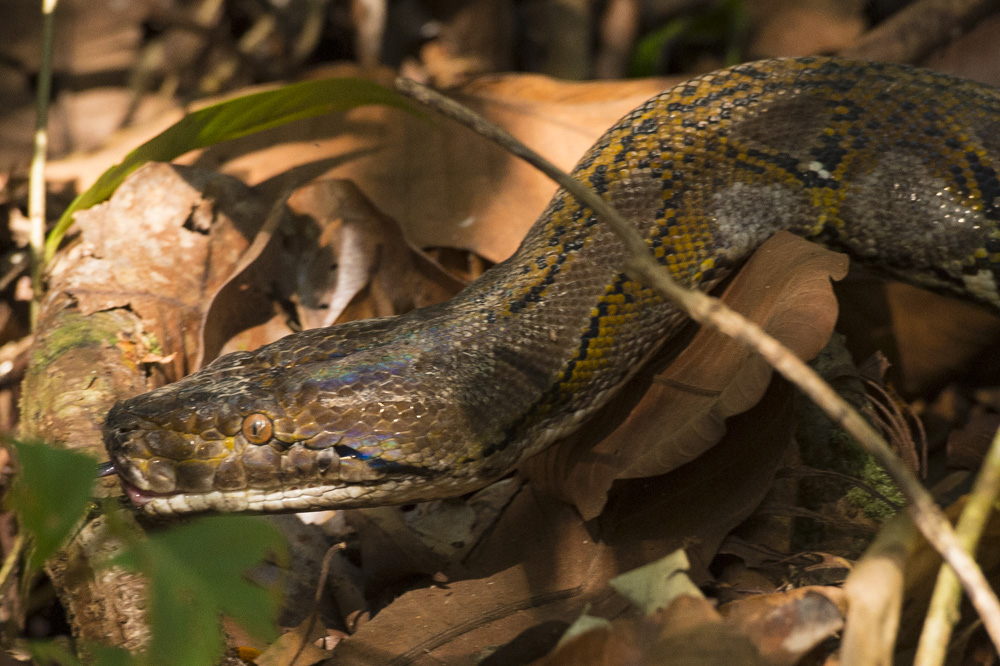
Ashley pointed out that our work for these animals has only just begun. Through our habitat protection work we must ensure that the forests stay standing, so the wildlife stays in the wild.
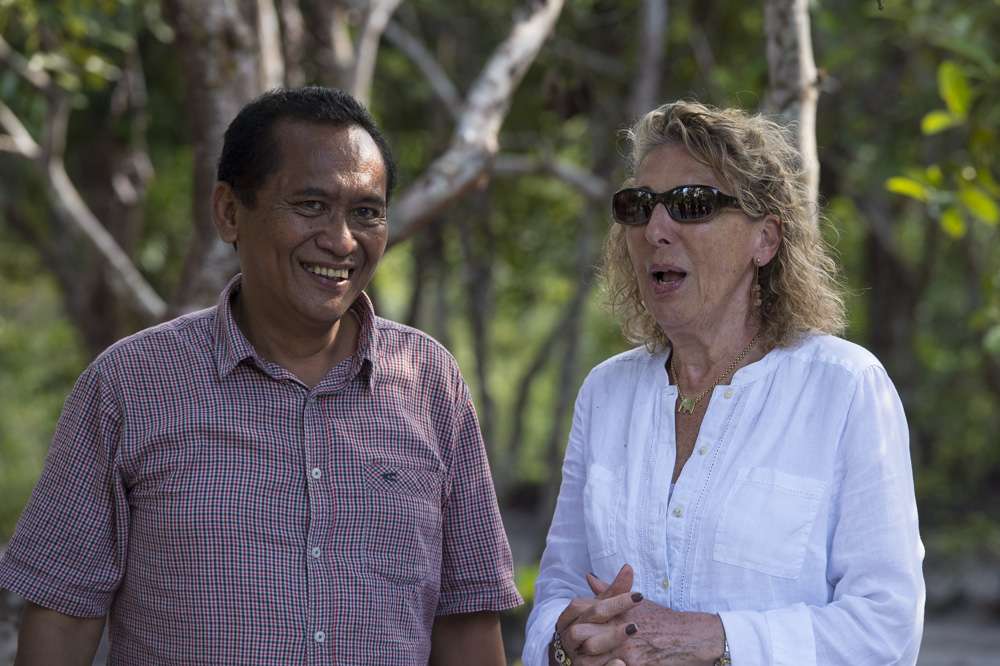
Please support our work, donate now.
Thank you.
Why Orangutan Foundation needs your support, more than ever.
If you are a member or supporter you will already know that our priority is protecting orangutan habitat. If we keep forests standing we can ensure orangutans stay in the wild (see video below of wild male). In the past few months our committed Indonesian staff, working on the front-line of conservation, have successfully:
- Detected and prevented illegal activities within two protected areas, home to thousands of Bornean orangutans and many other critically endangered or threatened species.
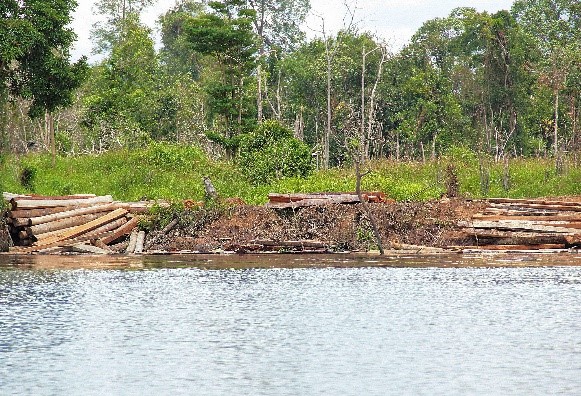
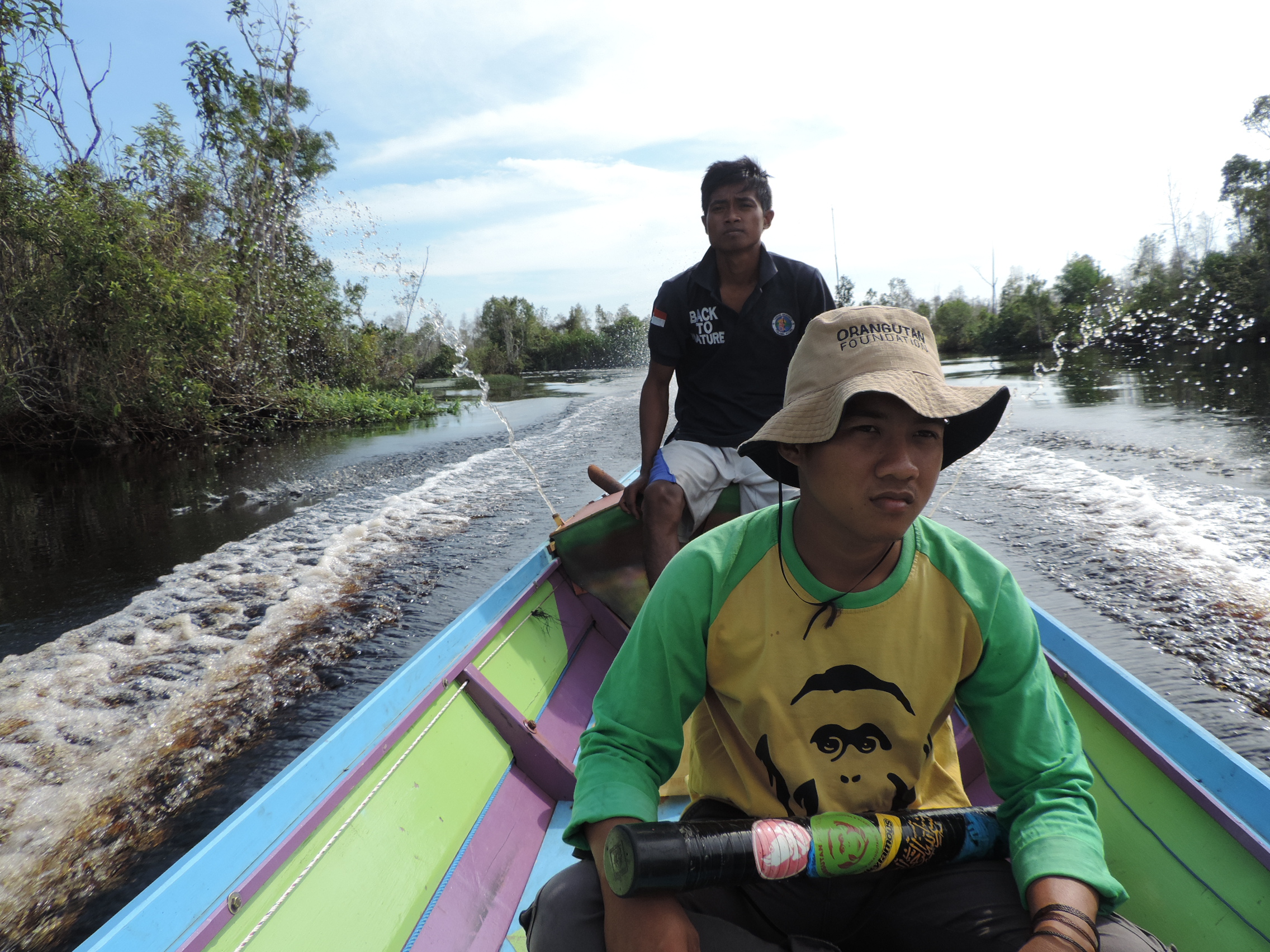

- Prevented the spread of fires to the Lamandau Wildllife Reserve, home to an estimated 500 Bornean orangutans.
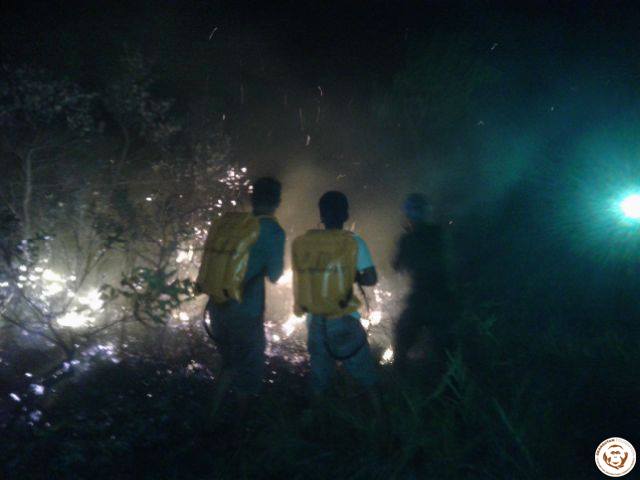
- Nurtured tens of thousands of tree saplings and planted in degraded forest areas of Tanjung Puting National Park and the Lamandau Wildlife Reserve.


- Trained our staff and community to prepare for and tackle fires
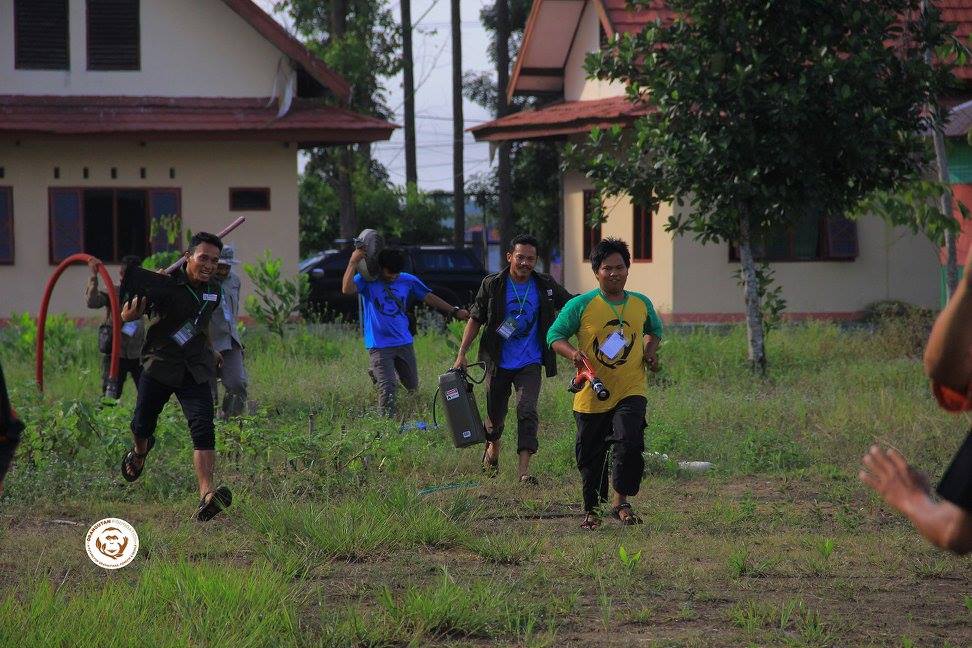
- Engaged with the Indonesian government and companies to implement best forest management in unprotected orangutan habitat.
We do all this so that wild orangutans, like the one below, stay wild.
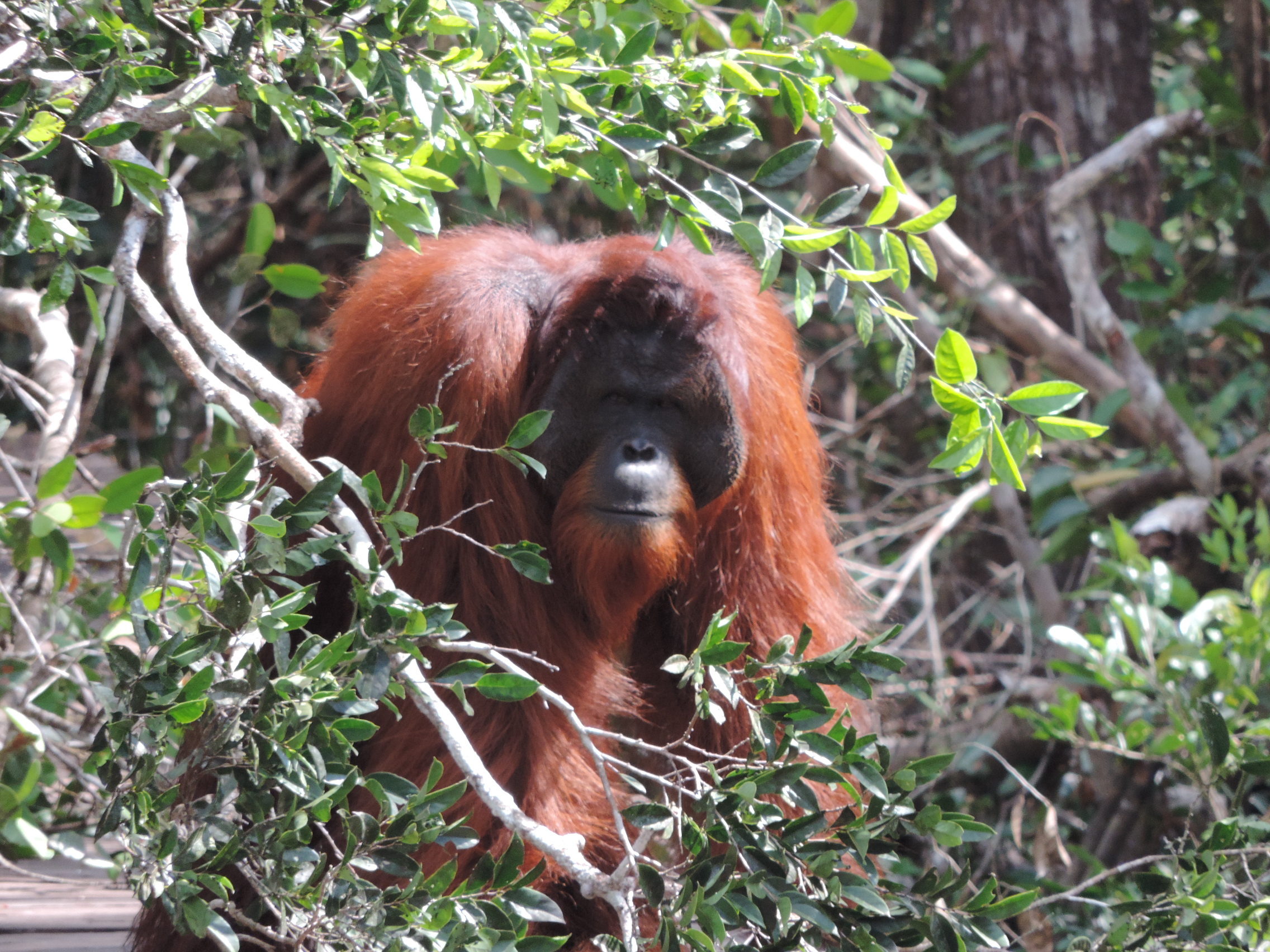
We need your help to continue doing this. If you haven’t already, please consider setting up a regular donation click here to support our vital work. Please also help by sharing this blog post.
Thank you,
From Orangutan Foundation - A future for orangutans, forests and people.
Adult male orangutan shows up at guard post
Some male orangutans start to look very different from females as they reach maturity, from the age of 15 onward. They develop cheek pads and bulk out, some weighing upwards of 120kg, double the average female. In the wild, one cheek-padded male will dominate an area of forest, with other cheek-padded males moving on to an area without another adult male in the vicinity.

Staff stationed at one of our guard posts in the Lamandau Wildlife Reserve, Indonesian Borneo, have reported the arrival of an adult male in the immediate vicinity of the post. Adult male orangutans generally do not pose an immediate threat as they possess a natural wariness of humans, however, this male clearly showed no fear and so was thought to be one that had been rehabilitated into the area.
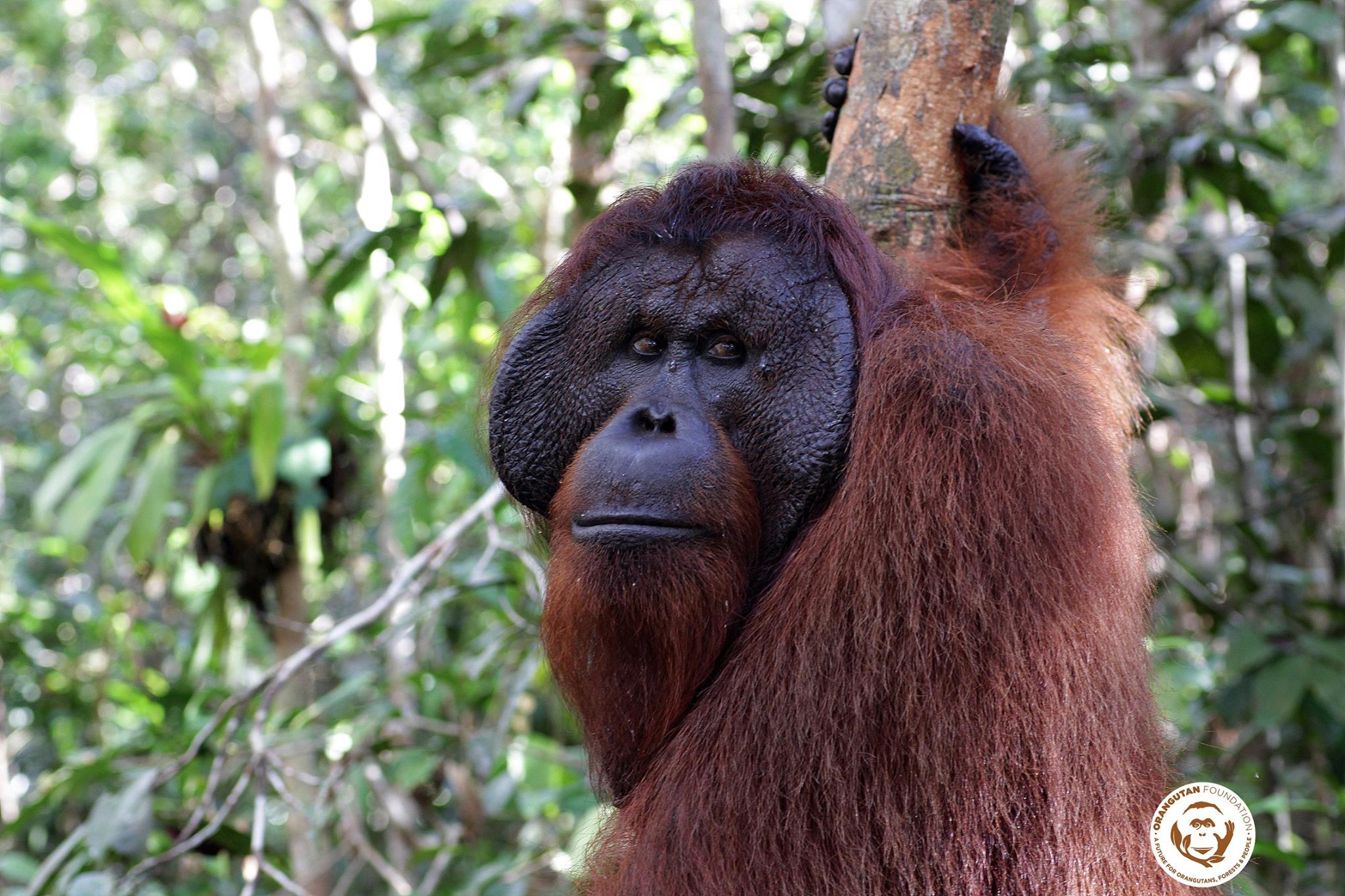
Guard post staff got in touch with staff stationed at the nearby Camp Siswoyo, who identified the male as Ofi, a male often seen in the forest surrounding the camp. Camp staff tried to encourage him to go back into the forest, as he was posing a problem to guard post staff who were unable to move about freely whilst he was close by.
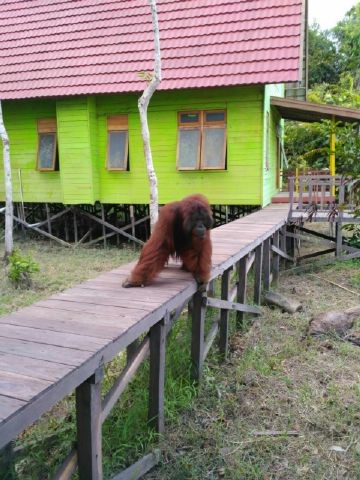
The last time camp staff reported seeing Ofi was back in July this year. Ofi shares the surrounding forest with dominant male Bangkal. Ofi is afraid of Bangkal and will make a swift exit anytime they meet, which is normal behaviour for a submissive male. You can read more about Bangkal here.
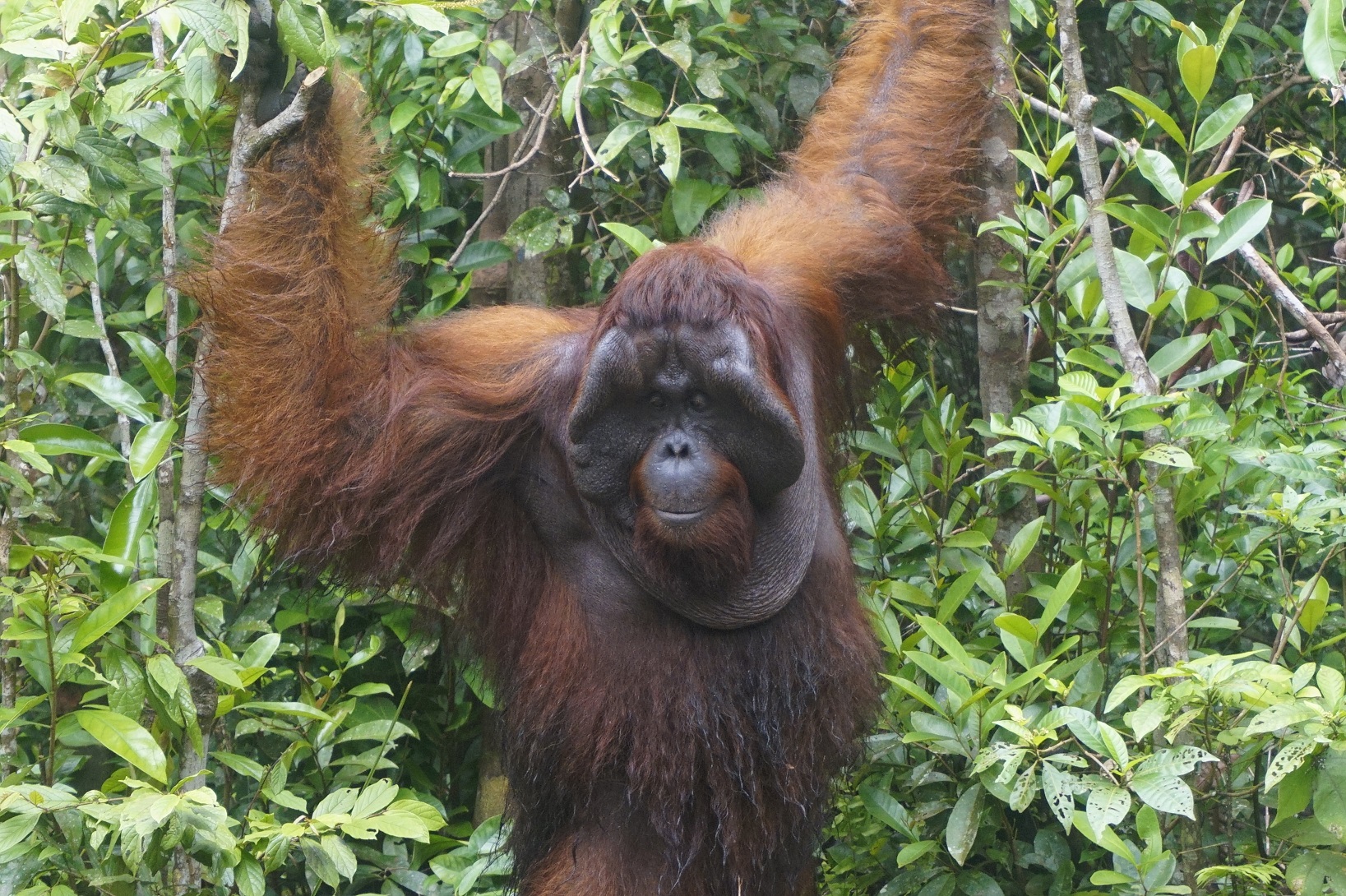
Since the guard post is only 5km away from camp, it is not far for an orangutan to travel, and staff believe he has moved away from camp as he cannot compete with Bangkal. Male orangutans are not territorial and have overlapping ranges, however, they do compete for resources, such as food, and fertile females.

Staff will monitor Ofi and if the situation does not improve, he will be tranquillised and moved into a suitable area of forest away from both camp and the guard post.

It costs £200,000 a year to protect the Lamandau Wildlife Reserve, home to Ofi, Bangkal, and hundreds of other orangutans. Please click here to support our work by giving a donation. Thank you.
Q&A with the Programme Manager of the Orangutan Foundation
People's Trust for Endangered Species (PTES) have been supporting the Orangutan Foundation's work in Indonesian Borneo for a number of years. We would like to share this Q & A with PTES and our Indonesian Programme Manager, Ade Soeharso, as part of the launch of their new appeal to save orangutan habitat.
Orangutan expert and Programme Manager at the Orangutan Foundation, Dr Ade Soeharso, answers some questions about the lives of orangutans, the dangers they are facing and ways anyone can save them now.
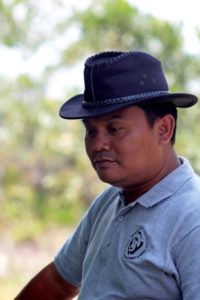
When did you start working at the Orangutan Foundation?
I’ve been a partner of the Orangutan Foundation since 2006. I was still working for the government then. Between 2008-2014 I worked part-time as a technical advisor of the Orangutan Foundation, and since 2015 I’ve worked full-time for the Orangutan Foundation.
What is the ideal habitat for an orangutan?
The ideal orangutan habitat is a mixture of swamp forest, lowland dry forest, and mountain forest. Ideally the habitat would be undisturbed and have an abundance of trees for food and nesting.
What is a protected forest?
In Indonesia, a protected forest is a one where the underlying area is protected from being logged or converted to other uses by land clearing.
What is palm oil? Why is the production of it so destructive?
Palm oil is a vegetable fat produced from oil-palm fruit. Almost all food products and many other common items use palm oil as a raw material. Therefore, palm oil is produced in large quantities because there is a huge market. Unfortunately, production of palm oil requires very large areas and which is achieved by cutting down large numbers of trees, which we call forest conversion and land clearing.
What have you found the hardest thing about working on the project so far?
The conservation of forests and the animals that depend on them is still often seen as less important than economic and development issues. It is challenging to mobilize the support of the parties in forest conservation efforts.
What is causing conflict between wildlife and the human population?
Due to deforestation, the amount of wildlife habitat left is ever decreasing. This means that the potential conflict between humans and orangutans will only increase. Orangutans and many other animals such as crocodiles, bears, and monkeys are forced out of the degraded forest and end up in community settlements and plantations in search of food. Seen as pests, they are often shot. We make sure that where possible, wild animals are translocated back into safe habitat. This is only possible if there is safe habitat left to move them back to.
What do you enjoy most about working with orangutans?
I enjoy it so much when I could see orangutans who have been rescued and then released growing and thriving in well-preserved habitat, successfully raising families of their own.
What time do you have to get up in the morning? Are orangutans early risers?
I get up early at 5:30 am. In the forest, orangutans rise between 5:00-5.30 am and leave their nests to set off in search of food.
How do you manage not to get lost in the forest when you’re following apes?
Basically, when following apes we’re never alone. There are always at least two people. As well as helping record data and times, they are locals who are more familiar with the forests so that we don’t get lost.
How many orangutans have you and your colleagues saved recently?
In 2017, so far we have saved 14 orangutans. Some of them have been released already as they are mature and well enough. The others are in the soft release programme. They are taken out into the forest each day to practice feeding and climbing until they have mastered the basic skills and are ready to be released.
Are you optimistic about the future for orangutans?
I am optimistic that orangutans can still be saved as long as we focus on saving their forests that are an integral part of their lives.
What must happen to ensure their survival?
We have to encourage the creation of sustainable oil-palm plantations and stop forest conversion in orangutan habitat and prevent the occurrence of forest fires. We also have to ensure that law enforcement act so that no more orangutans are traded as pets.
What can our supporters do to help?
As well as donating to this project, if you are buying a product that is made using palm oil, look out for ‘sustainable palm oil’ on the label. Currently, the global area already being used for oil palm production is sufficient to meet our needs without any further loss of forest. It is possible for us to use oil-palm produced from sustainable palm oil plantations and it is something we can all to do.
Please help us to help orangutans today so that they are still here tomorrow.
Severely Malnourished Male Orangutan Rescued from Fragment of Forest in Indonesian Borneo
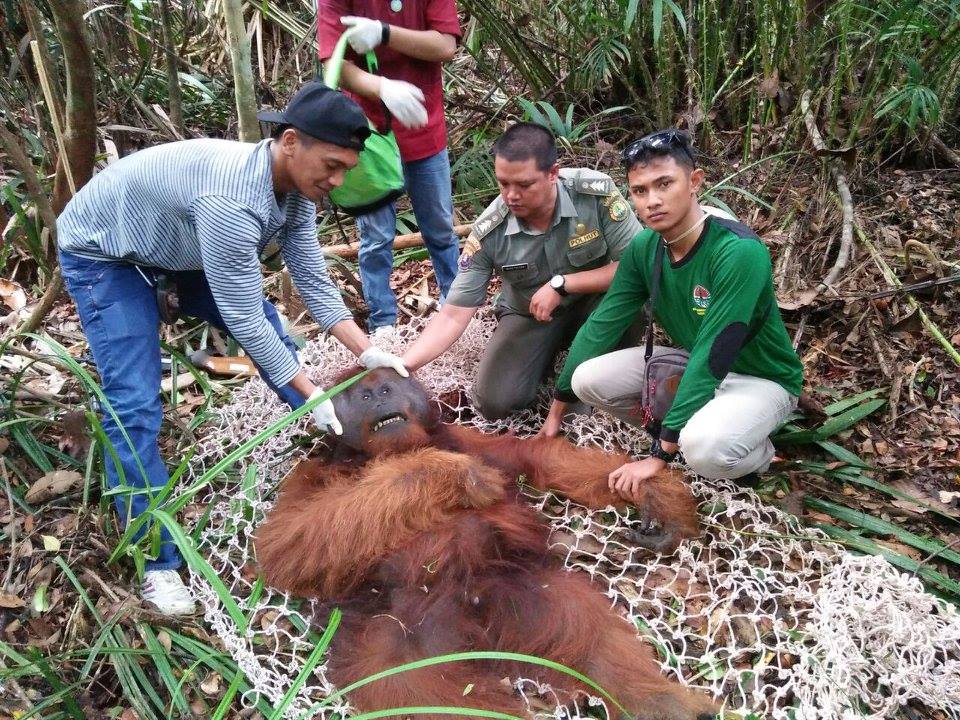 On Monday, 28th August 2017, Orangutan Foundation together with the local wildlife authority, managed to rescue an orangutan, found stranded in a forested area between a village and an oil-palm plantation in Central Kalimantan. The orangutan, an adult male of around 17 years of age, only weighed 80kg - about two thirds its expected weight..
On Monday, 28th August 2017, Orangutan Foundation together with the local wildlife authority, managed to rescue an orangutan, found stranded in a forested area between a village and an oil-palm plantation in Central Kalimantan. The orangutan, an adult male of around 17 years of age, only weighed 80kg - about two thirds its expected weight..
The alarm was raised by one of the villagers, who, seeing the orangutan so close by, was worried the orangutan would destroy his oil-palm plantation, and even enter his own home.
The challenging terrain made it difficult to reach the orangutan. The team had to use a boat to approach the area and then walk about 1km through swamp forest. On arrival, the orangutan was anesthetized to take it to a point of safety.
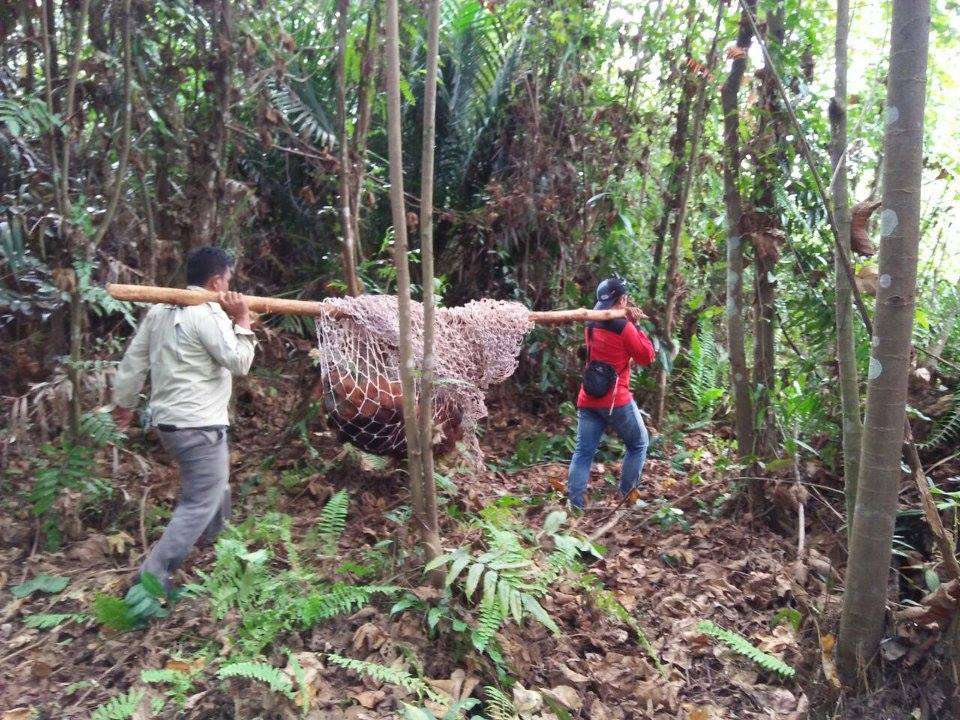
This rescue highlights the problem of habitat loss resulting in more wildlife coming into human contact, leading to human-wildlife conflict.
The orangutan will be examined by the Orangutan Foundation’s vet, and then translocated into the Lamandau Wildlife Reserve, a protected area on 30th August.
To date, 15 orangutans have been rescued in 2017, some being immediately translocated and others, too young for release, will go into the Foundation’s Soft-Release Programme. Please donate to support our rescue and release programme.
Video: Dramatic orangutan rescue
This video shows the challenges faced by our staff when rescuing orangutans:
On the 3rd July, our staff received reports from the Wildlife Department (BKSDA) of yet another orangutan that had been found in community land. At that stage they had no idea of the difficulty of the terrain and where or what condition they would find the orangutan in. After preparing the anesthesia, our staff set off to the rescue location.
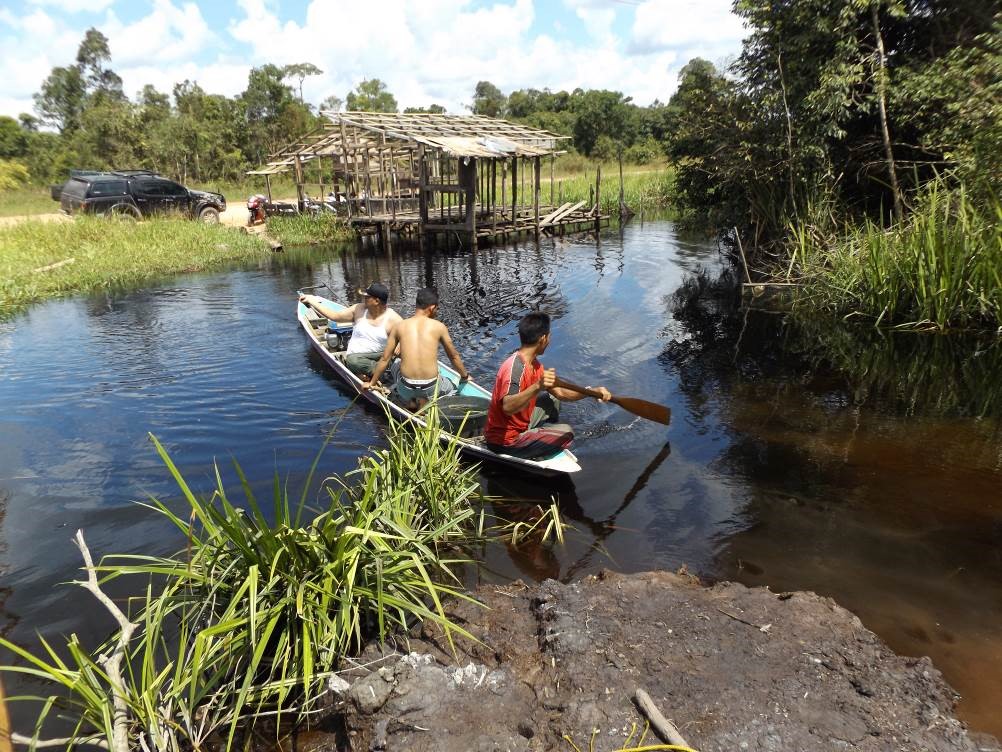
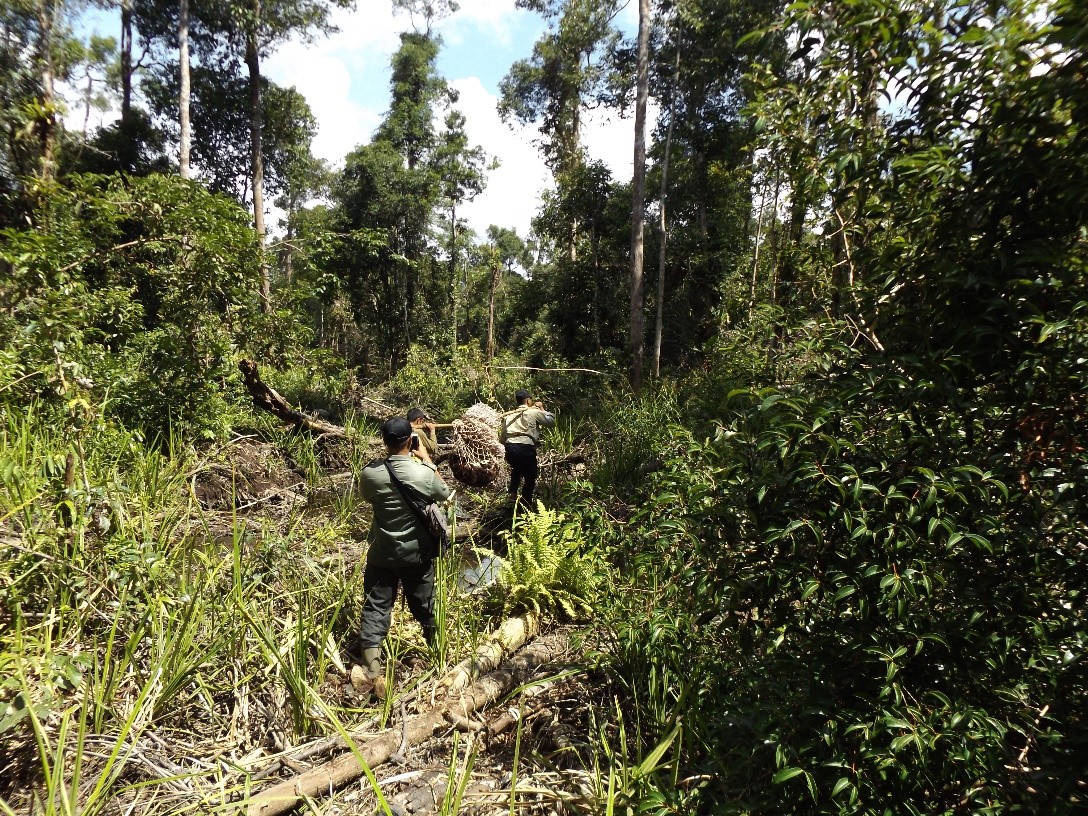
It soon became clear this was going to be difficult. They had to cut through dense undergrowth to reach the orangutan, which was high up in a tree. Our anaesthetist had to climb up a tree to get a clear sight of the ape before firing the dart gun. The staff, ready at the bottom of the tree with a net, caught the orangutan as it fell. Our vet was waiting to assess the orangutan, who was a female of around 20 years. Sadly though, he discovered previous injuries to her back and chest, which would require treatment.

The orangutan was named Karin and on returning from the rescue location she was examined and given treatment for her wounds.

After recovering from her ordeal, Karin was taken to Camp Gemini, an orangutan release site, in the Lamandau Wildlife Reserve (Central Kalimantan, Indonesian Borneo). Once Karin’s wound has healed she will be free to live back in the wild again.
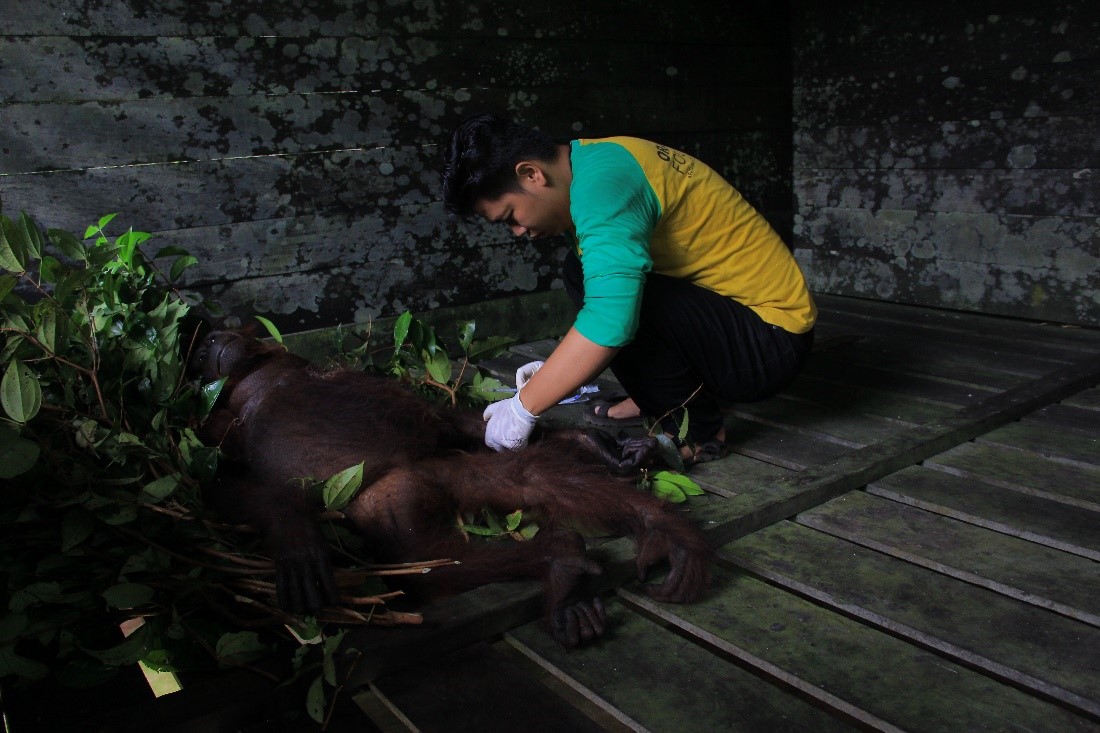
The loss of forest is causing orangutans to come into contact with humans as never before. Support the protection of Karin’s future forest home and become a Guardian of the Lamandau Wildlife Reserve.
Thank you.
The Lamandau Wildlife Reserve
We are delighted to be able to convey the news that two of our soft-release orangutans, Jessica and Ketty, have now been released into the Lamandau Wildlife Reserve. Staff are confident both will go on to living fulfilling lives in the wild, free from the threat of habitat loss.


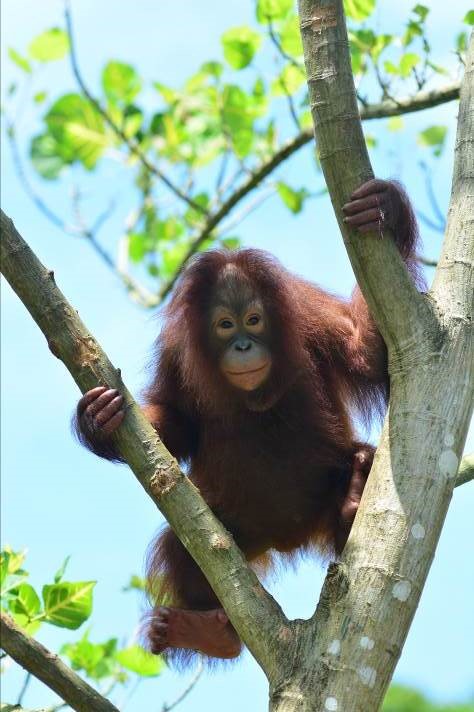
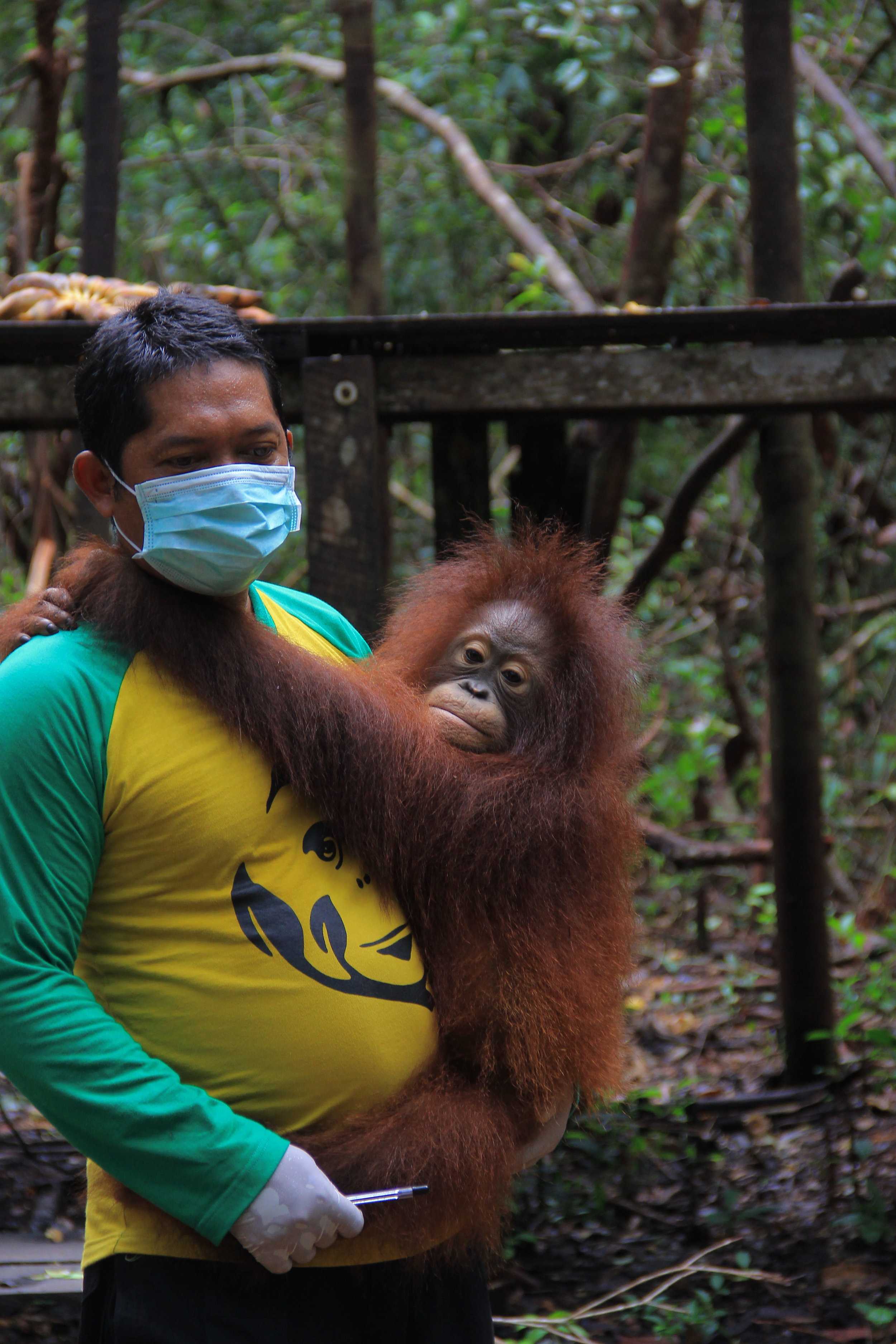
In light of this positive news and #RainforestLive, we are introducing a new initiative in support of the Lamandau Wildlife Reserve.
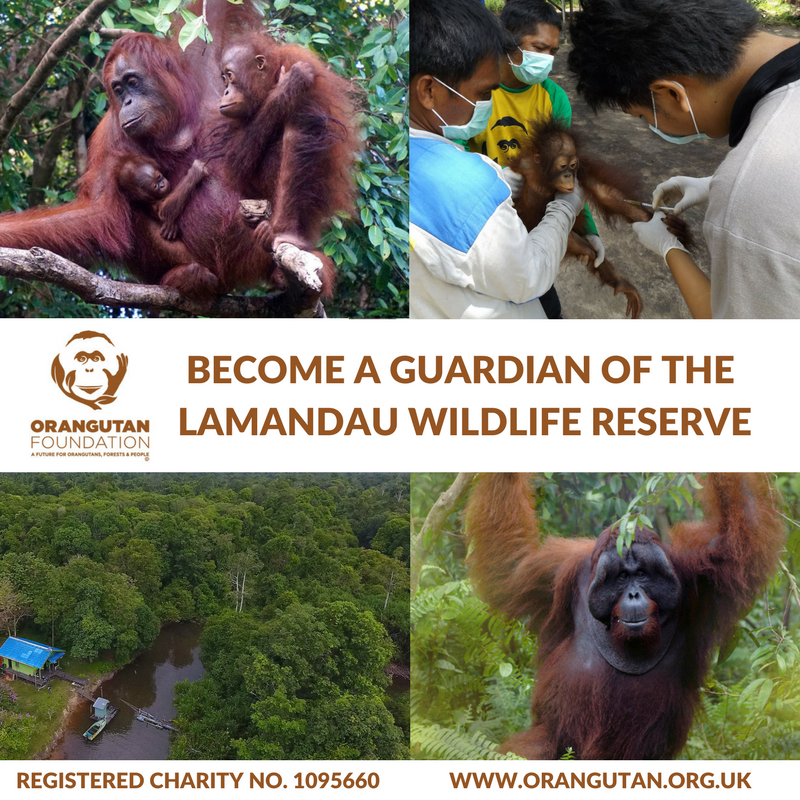
Become a guardian and actively protect:
- 158,144 acres of tropical peat forest in Central Kalimantan, Indonesian Borneo
- 500 critically endangered orangutans - a number which continues to increase as more are rescued and released
- thousands of threatened species including gibbons, sun bears and clouded leopards
- 5 million tonnes of stored carbon.
A regular gift of £16.50 a month or a one-off donation of £200 for the year (the equivalent of 55p a day) will contribute towards the management of the Reserve.
Visit our webpage for more information on how to become a guardian.
Rainforest: Live 2017
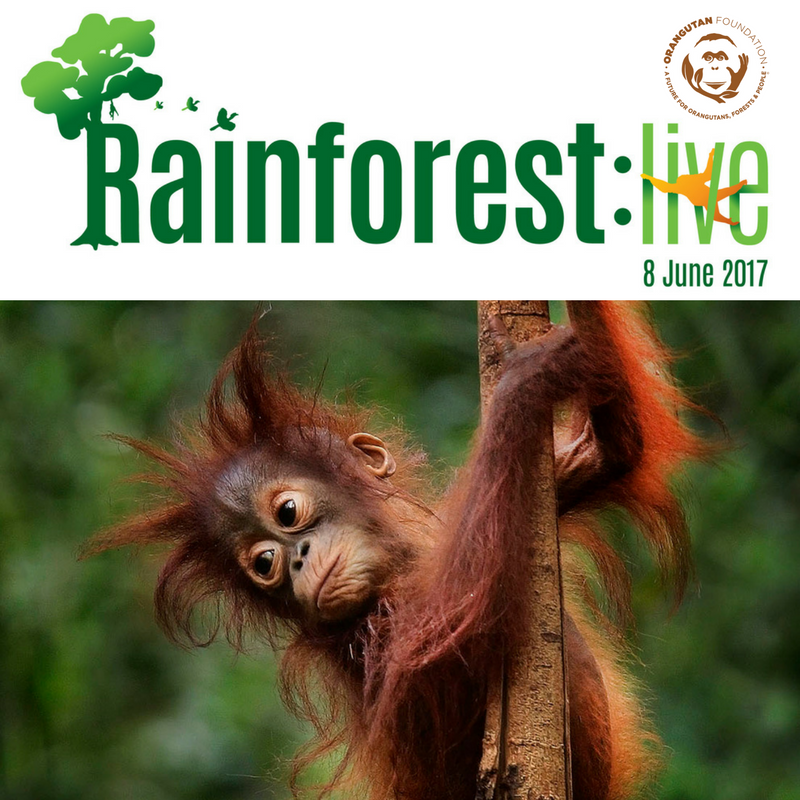 This year we again take part in Rainforest: Live, a global social media event set up by Borneo Nature Foundation, with more than 50 organisations taking part.
This year we again take part in Rainforest: Live, a global social media event set up by Borneo Nature Foundation, with more than 50 organisations taking part.
Organisations will share a glimpse of rainforest life on social media to inspire people to take action and help protect these critical habitats.
WHAT TO WATCH OUT FOR: Rare and wonderful wildlife sightings direct from rainforests all around the world! Here's a clip we posted last year to give you a taste of what is to come:
You can learn more about the event here.
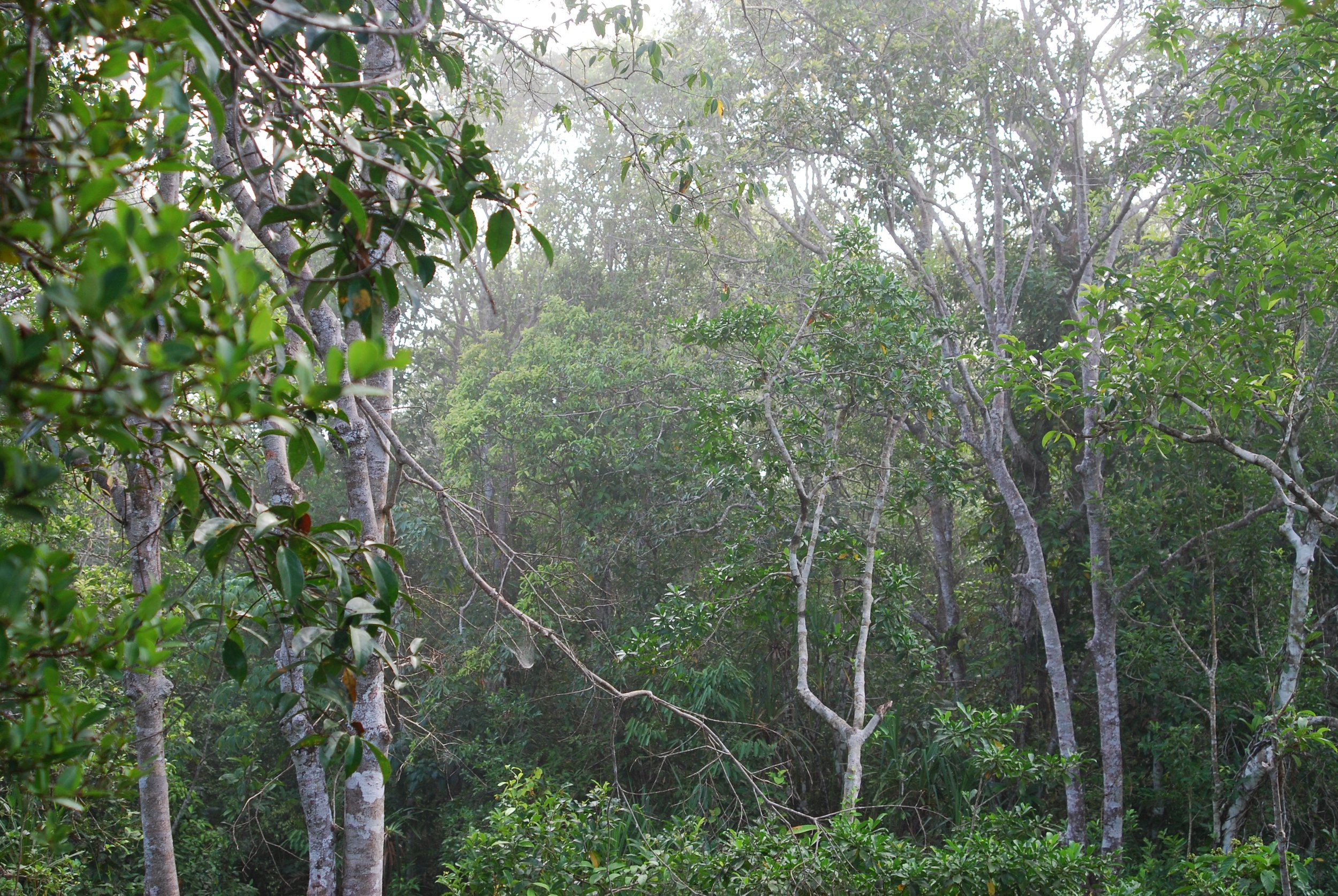
Rainforests once covered as much as 12% of the earth's landmass. They now only cover 5%, largely a result of human activity. Help us to protect the world's remaining rainforests, estimated to be home to as much as half of all species of flora and fauna found on earth, including the magnificent orangutan.
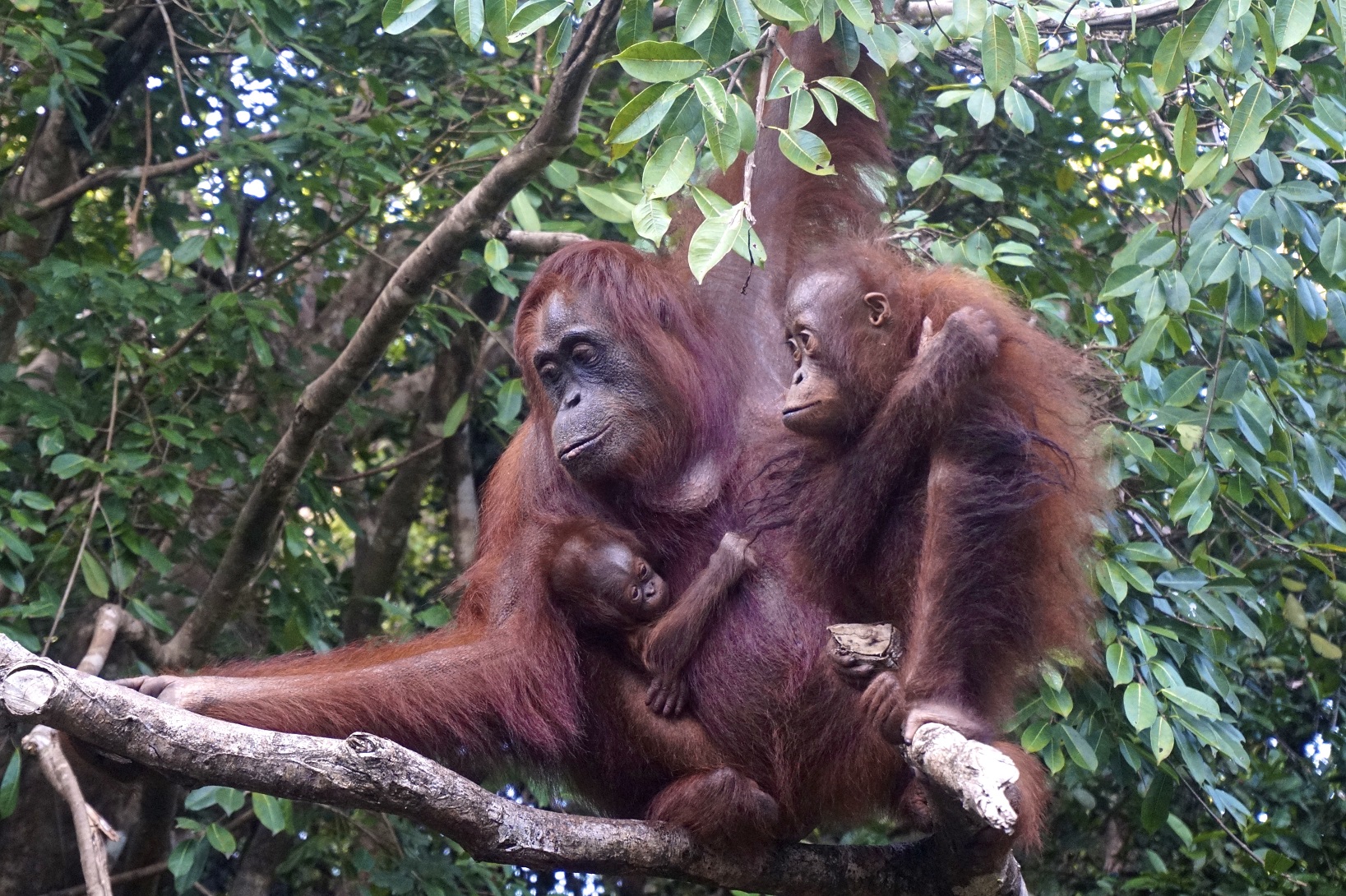
Join us tomorrow on Facebook, Twitter, Instagram, Tumblr and Pinterest and please show your support for rainforest conservation by getting involved – follow the hashtag #RainforestLive and share, like, retweet and comment!
Meet Our Soft-Release Orangutans - Part 3
In this blog entry we focus on Camp Rasak, where orangutans in the final stage of the soft-release programme before their release into the wild are monitored. The Lamandau Wildlife Reserve in Indonesian Borneo is a protected reintroduction site, where rescued orangutans can be released safely.
From this Reserve we run our Soft-Release Programme for rescued orangutans too young to return to this wild. Watch this short clip to find out how this programme equips these orangutans for a life in the forest:
Reintroduction Camps
There are 5 Camps located in Lamandau:

Depending on the age and development of the orangutan they are placed into one of the camps which is best suited for their needs. Camp staff monitor all rescued orangutans.
Currently we have 10 orangutans within our soft-release programme.
Meet the orangutans being cared for at Camp Rasak…
Endut
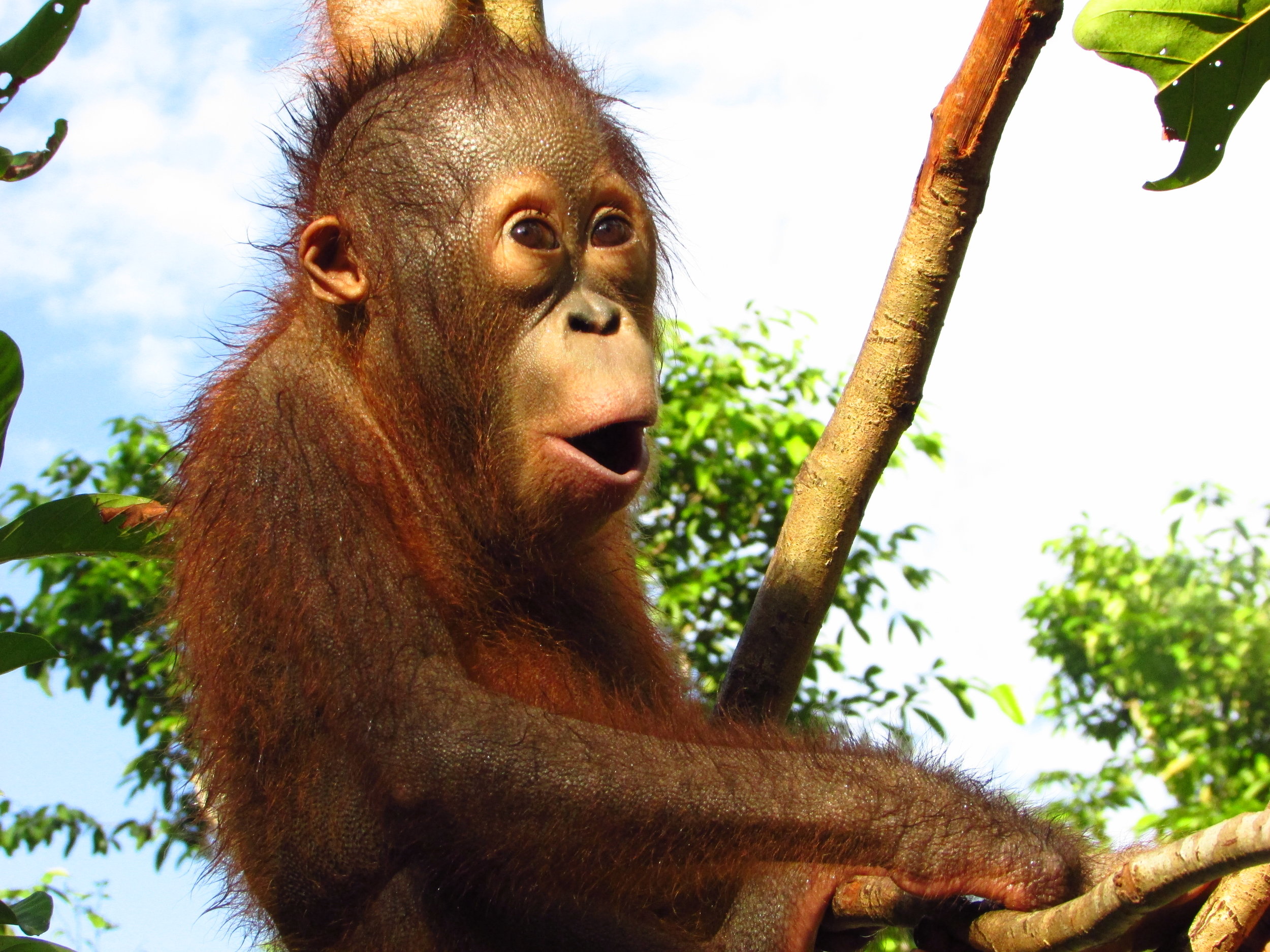
Endut is a 3 year old male who was rescued last March, named after his rather round belly. Endut is improving his climbing skills and has become much braver in the past couple of months, but is still has a way to go in order to be ready for release.
Ketty
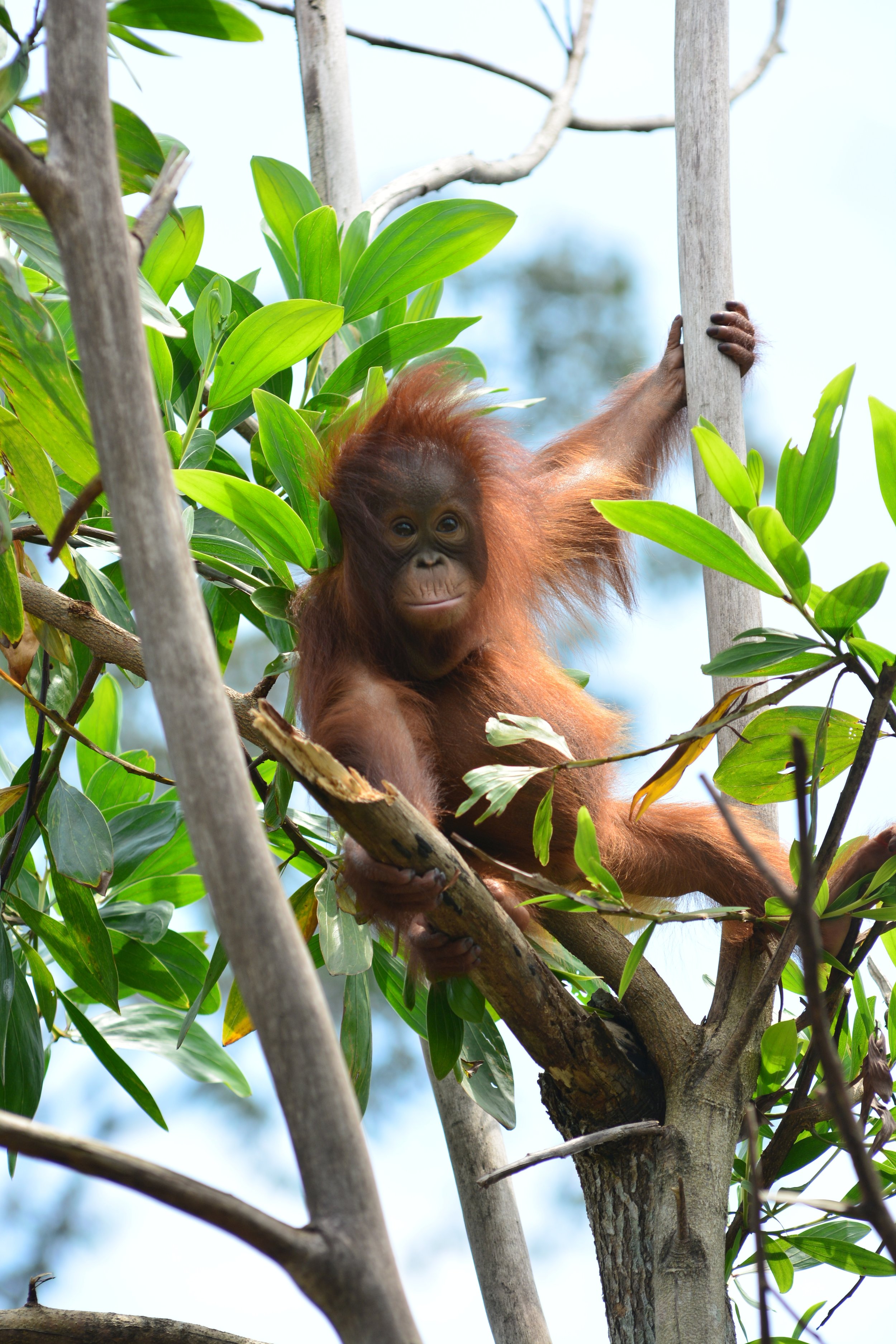
Daughter of Korin, a reintroduced orangutan who inhabited the forest around Camp Gemini. Korin sadly disappeared in 2013 and Ketty was found alone. Since joining the Programme Ketty has come along in leaps and bounds, or should we say, climbs and swings!
At 5 years of age,she's always displayed skills more advanced than the orangutans being cared for alongside her, which is likely a result of spending some time with her mother in her early years.
Jessica
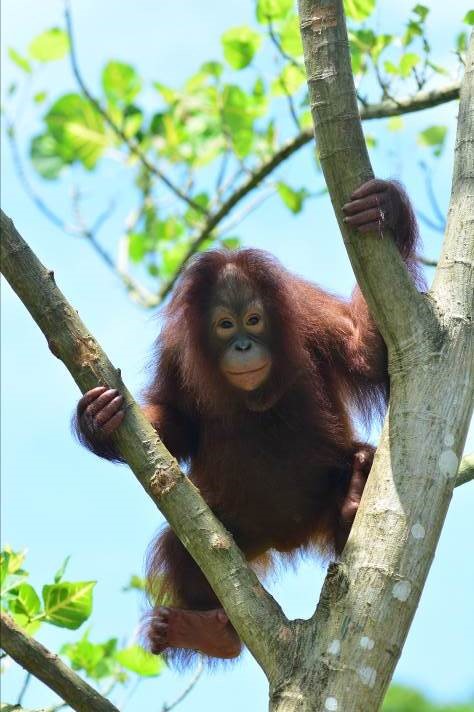
Jessica was rescued from a local town where she was being kept as a pet in 2016. In spite of this she retained her natural instincts well and didn't take long to adapt to life in the trees. At 5 years of age, she is advanced in her progress, displaying excellent survival skills.
What Next…?
After keeping a close watch on Ketty and Jessica, staff are now confident that they have the skills required to live in the wild: nest-building, finding food, and climbing to the top of the canopy.
The Soft-Release Programme exists within the same area of forest where orangutans are released. As past experience has shown, once released orangutans are often seen in the forest around camp so we are able to continue to keep a watchful eye on them.
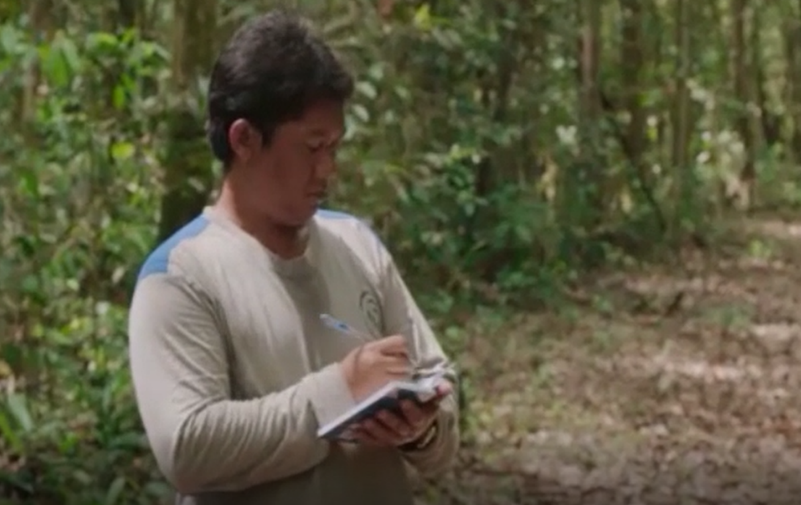
Following release, orangutans are monitored for two weeks so that staff can ensure they are adapting well to living independently. Once released, we hope all will go on to live fulfilling lives in the wild, away from the threat of habitat loss and human activity.
Next week we follow the release of Ketty and Jessica!
Support our Soft-Release Programme and adopt an orangutan today.
All proceeds from our Adoption Scheme go towards medical treatment, food and care of these orangutans during their time in soft-release.
The Orangutan Foundation's 5 Programmes in Indonesian Borneo
Watch this short video to learn about our 5 ongoing programmes in Indonesian Borneo:
Please help us ensure a future for orangutans, forests and people. To support our work with a donation, please click here.
Thank you.
The Forest - A Message of Thanks
We have just received a wonderful message from our Research Station Manager, Fembry Arianto. The Orangutan Foundation manages Pondok Ambung Tropical Forest Research Station, which lies within one of Southeast Asia’s largest protected areas of tropical peat swamp and heath forest, Tanjung Puting National Park, Indonesian Borneo.

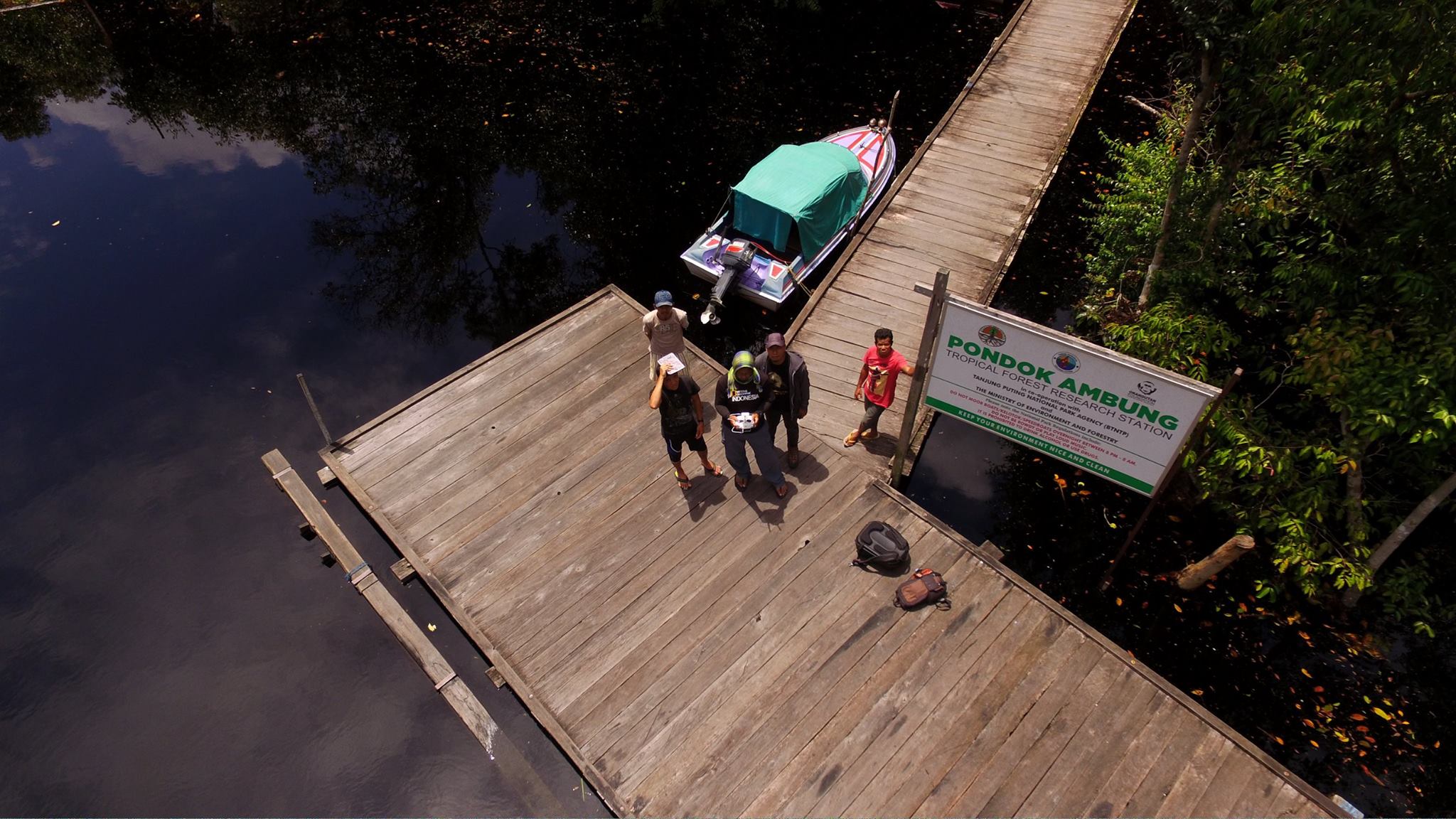
"The Forest…the place where I can rest, think, learn, observe and create my future…thank you to all my colleagues who always give great support and work together so well.
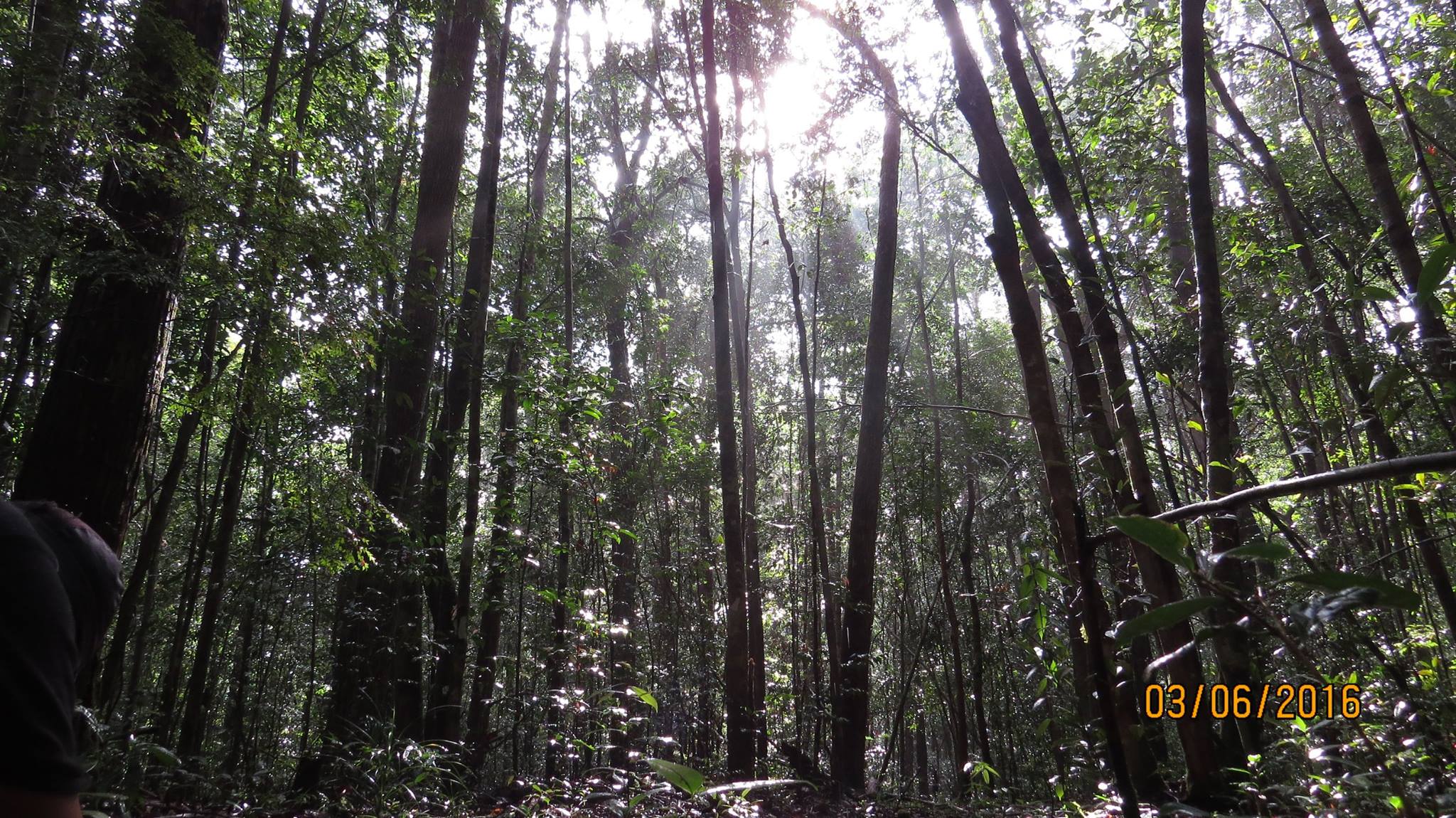
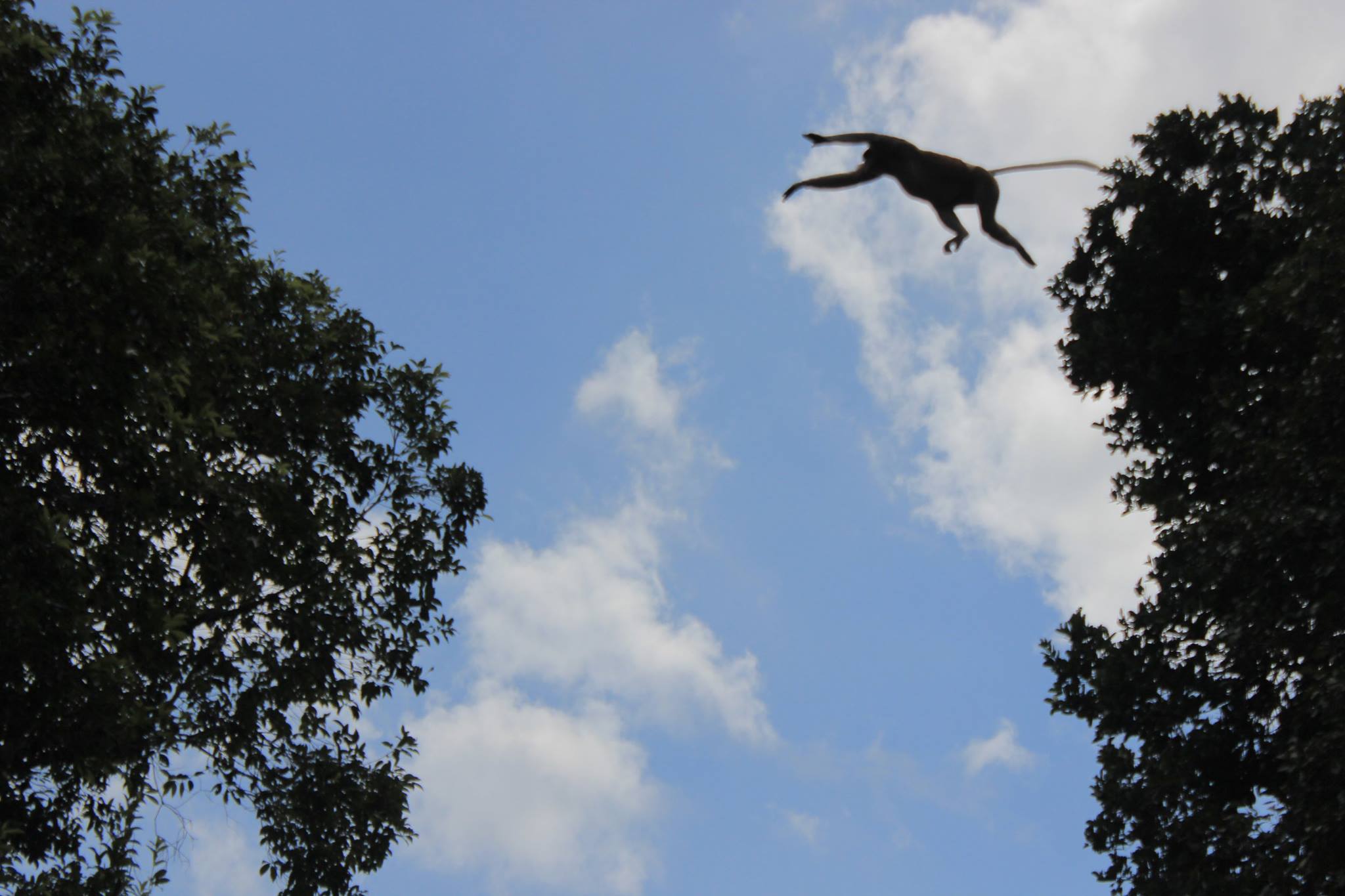
Today marks 3 years and 21 days of working for the Orangutan Foundation, I’ve given and received so much from this organisation…thank you for everything, the passion runs deep!"
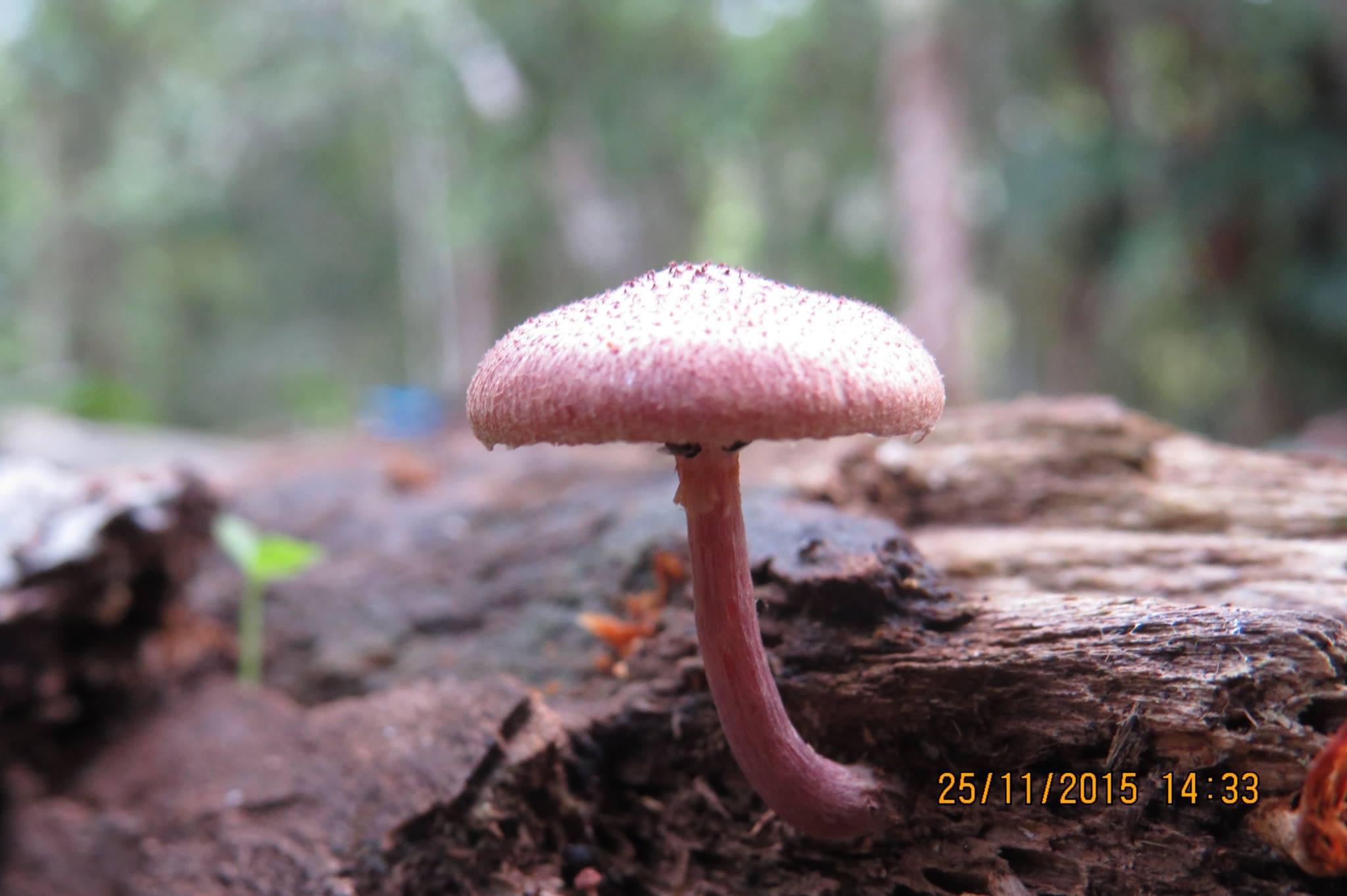
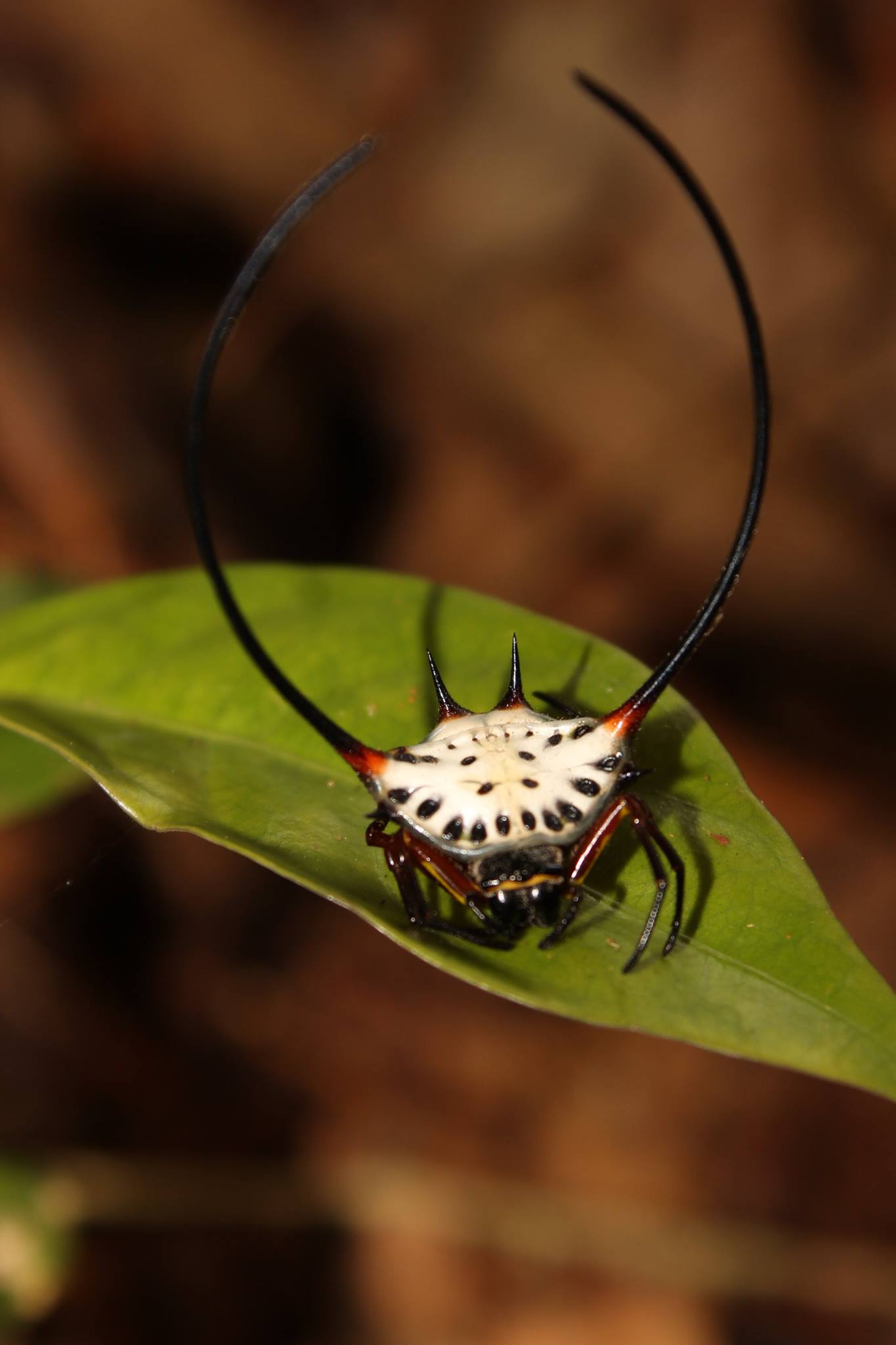
There is a rich diversity of species around the station including orangutans, proboscis monkeys, gibbons, kingfishers, tarsiers, false gharial crocodiles, black rayed softshell turtles, clouded leopards, bintorungs and sun bears.
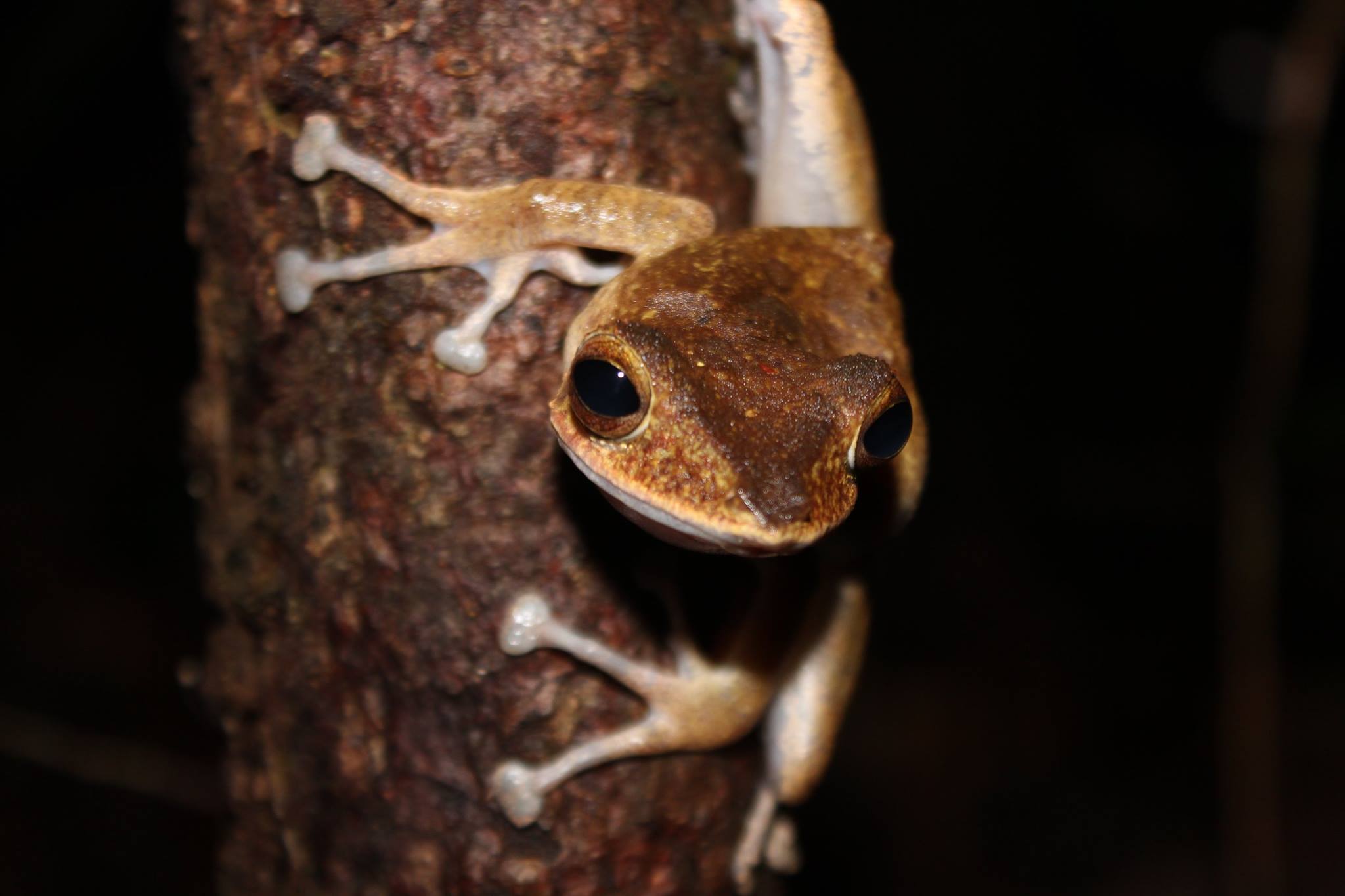
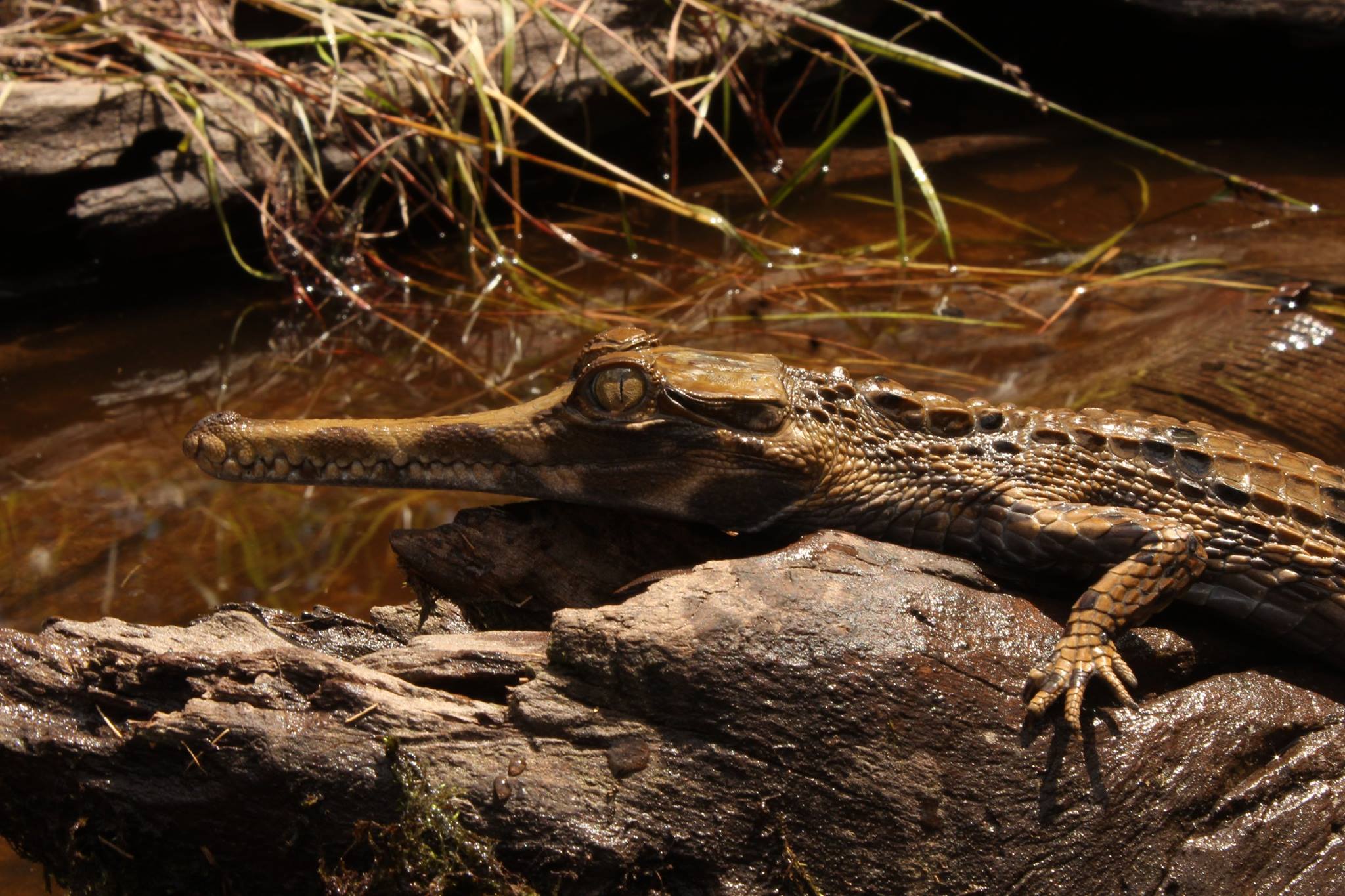 Pondok Ambung is available for use by individuals wishing to conduct research within Tanjung Puting National Park.
Pondok Ambung is available for use by individuals wishing to conduct research within Tanjung Puting National Park.
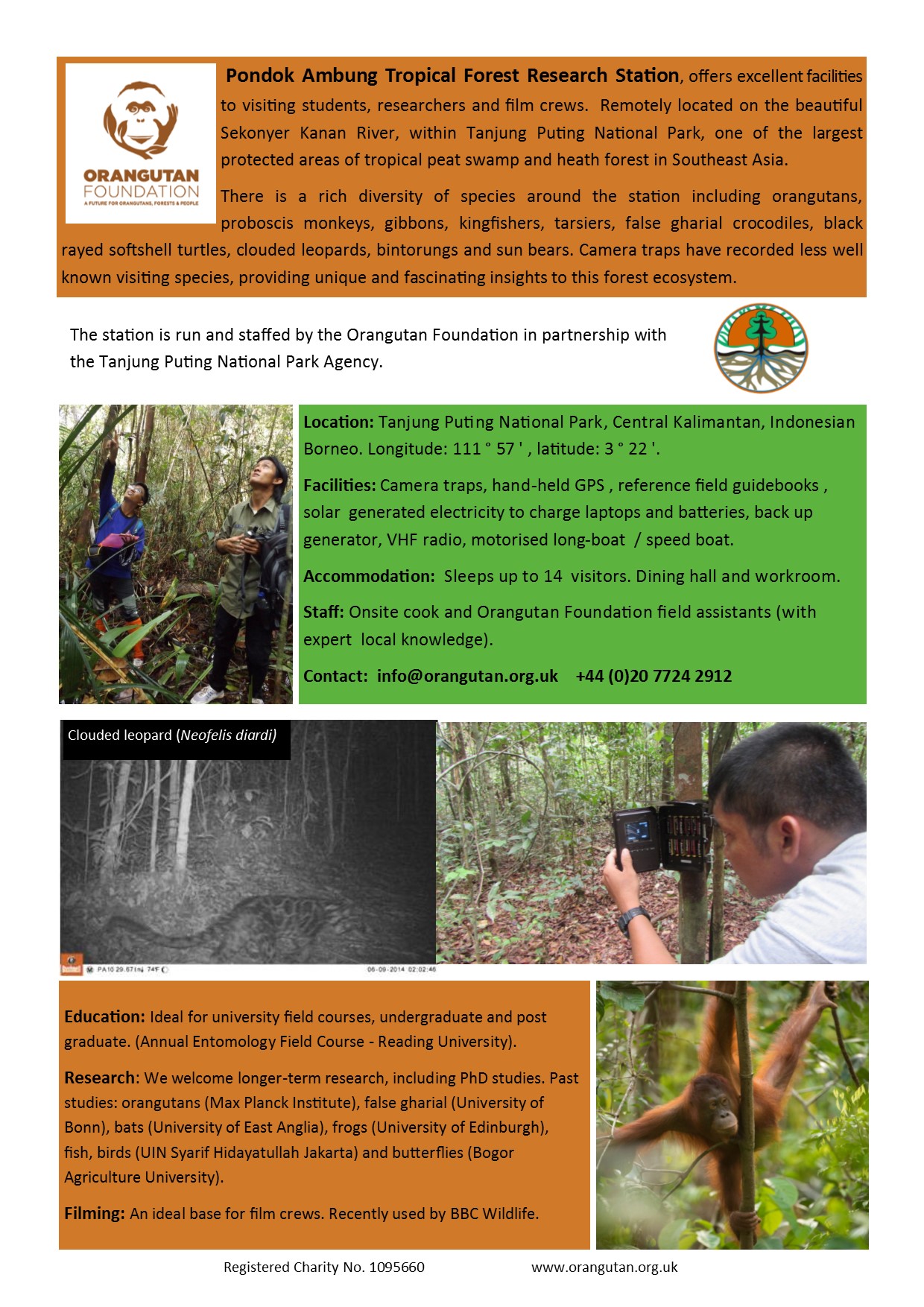
For more information please get in touch with our UK office info@orangutan.org.uk.
All photos show the grounds and variety of wildlife which can be found around Pondok Ambung Research Station, taken by Orangutan Foundation staff.


